nutrition
A really good bit of investigative journalism by BBC Inside Out South West.was shown on Wednesday 12th November 2008. Unfortunately it was shown only in the South West. If you are in the UK you can see it on BBC iPlayer. There is a clip on Youtube. It features some very sensible comments from a real dietitian, Catherine Collins, and from Ben Goldacre .
The College of Natural Nutrition is not a university. In fact it is an industrial building in Tiverton, Devon.

(Could that be a tutor in the window?)
But some of the courses are given in the far grander surroundings of Regent’s College in London.
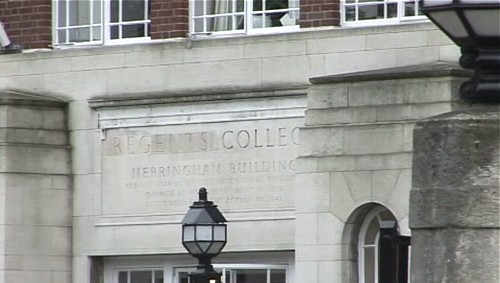
The College of Natural Nutrition diploma (over £1300) is the only qualification of Barbara Nash. Nash is the ‘nutritionist’ who treated Dawn Page with a ‘hydration diet’, that resulted in organ failure, epilepsy and brain damage. Nash’s insurers paid £800 000. in damages, but didn’t admit liability.
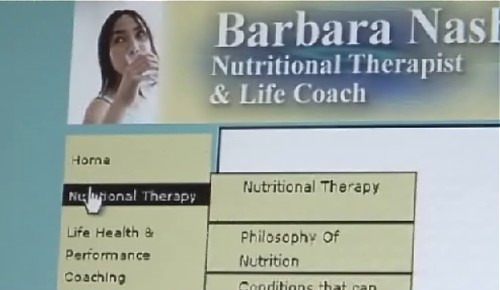
Dr Ben Goldacre pointed out that it perhaps isn’t surprising that people like Nash so often act far beyond their competence because they are being “aggrandised by the strange made-up colleges and bodies that are training and accrediting them”.
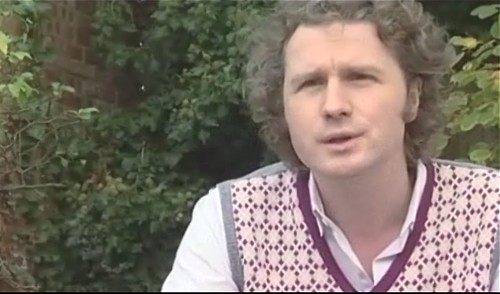
When you see some of the things she was taught, it isn’t surprising. Secret video recording revealed some totally bizarre teaching by the College principle, Barbara Wren.
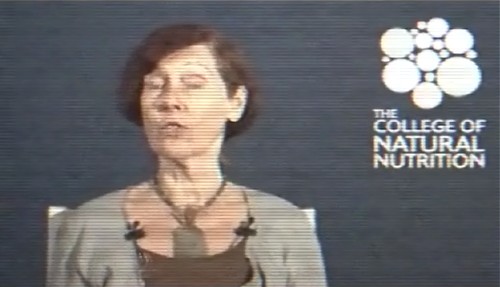
She claimed to have cured thyroid cancer by applying external compresses, half an hour with castor oil and half an hour with your own urine. Claiming to be able to cure cancer is illegal. Of course that isn’t done in public, just in private (a bit like Boots’ advice on useless supplements)). The BBC did some secret filming.
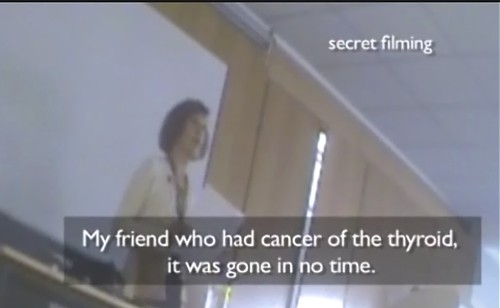
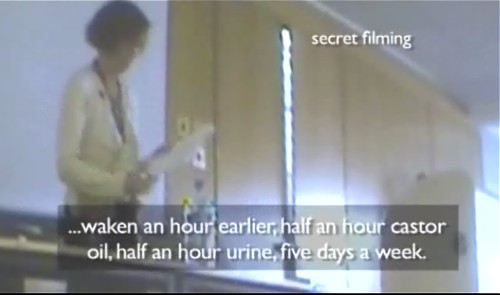
And what caused the cancer? A computer stored under the bed.

Catherine Collins commented “It would be laughable if it wasn’t so serious.
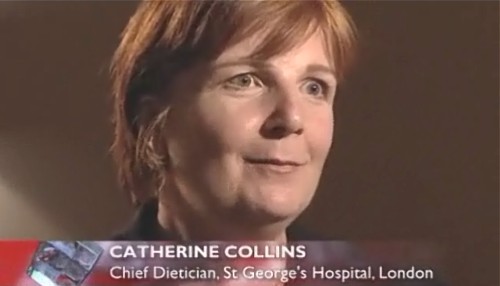
In another lecture, Barbara Wren sounds very peevish because she is going to be prevented from “prescribing” 25 times the safe dose of iodine. She advises her hapless customers to go to a pet shop and buy Lugol’s (iodine) solution, used to treat fish tank water, so they can poison themselves in peace.
The College of Natural Nutrition, and Barbara Nash, are both still in business The web site of the former has the disclaimer
“People who take the information and make decisions regarding their health or medical care, which they believe are based on ideas contained in this website, do so at their own risk. The author and publisher are not responsible for any adverse effects or consequences resulting from the use of any of the suggestions or information contained in the website “
I doubt if that is enough to exempt you from the Cancer Act. Anybody who does make medical decisions based on this utterly batty advice might be thought to deserve what they get.
Alternatively, if you are daft enough, buy the course..

Postscript. Some other blogs that give good information about this topic include Thinking is Dangerous and NHS Blog doctor
Thames Valley University is one of those shameful institutions that offer Bachelor of Science degrees in homeopathy. They don’t stop there though. They’ll teach you several other forms of make-believe medicine. Among these is “nutritional medicine”. This is taught at the Plaskett Nutritional Medicine College which is now part of Thames Valley University.
 |
 |
Everyone is for good nutrition of course, but ‘nutritional medicine’, or ‘nutritional therapy’ pretends to be able to cure all sorts of diseases by changes in diet or by buying expensive nutritional supplement pills. It has no perceptible relationship to the very important subjects of ‘nutrition’ or ‘dietetics’. Nutritional therapy is very firmly part of alternative medicine, in other words it is largely quackery. If you don’t believe that, read on.
The subject of nutritional therapy was in the news recently because of Matthias Rath. He is the person who is reponsible for the death of many Africans because of his advocacy of vitamin pills for the treatment of HIV/AIDS. He didn’t just (mis)treat people, but also played a role in persuading the recently departed Thabo Mbeki, and his health minister (“Mrs Beetroot”) to abandon effective therapies for AIDS sufferers. See reports in The Guardian, by Ben Goldacre, and here,
I’ve written a lot about the penetration of quackery into universities, and I thought I’d seen the worst with ‘amethysts emit high yin energy‘. But, as Goldacre said, let me tell you how bad things have become. .
Recently I came into possession of a lengthy set of notes for a first year course on “The Holistic Model of Healthcare”. The notes are from the 2005 course at Thames Valley University, They are not signed, but appear to have been written by Dr Lawrence Plaskett himself. . You can download the whole set of notes here.

Here are a few choice quotations. The basis of them is pure vitalism. They read like a throwback to the dark ages. Little comment is needed. They speak for themselves.
1.3 What do Orthodox Dieticians know about Food and Health?
Dieticians working in the National Health Service and private clinics and hospitals are usually well trained in the basics of the subject, though they too have an entirely orthodox slant. By and large they seem to accept the general view of most of the medical profession that nutrition does not affect illness much. Hence, they restrict themselves to designing diets required by the doctors for whom they work – usually for specified narrow purposes, such as low fat diets, low sodium diets etc. Such diets are, indeed, important in the hospital management of certain diseases (once these have become established) but they represent extremely limited horizons. Much that is in the basic and essential training of alternative nutritional practitioners is missing from the training of dieticians. As a result, most hospital diets are not very good for health judging from the parameters that will be set down in the following Sessions
Well, it is true that real dietitians prefer not to base their practice on mediaeval vitalism. That is what marks them out as professionals.
1.4 Relationship to Science and the Limitations of Orthodox Methods
However, the subject of Wholistic Nutrition transcends the area of human understanding for which science, alone, is appropriate. The reason is that it is ‘vitalistic’. It recognises the presence in all life forms including the human body, of subtle (or ‘etheric’) energy forces not easily measurable by the physicist’s equipment. It shares that position with the ‘energy medicine’ disciplines such as homoeopathy, traditional acupuncture and spiritual healing. It follows an approach to those subtle energies that is embodied in the discipline and philosophy of naturopathy.
Vitalism is the notion that life in living organisms is sustained by a vital principle that cannot be explained in terms of physics and chemistry. This vital principle, often called “the life force”, is something quite distinct from the physical body and is responsible for much that happens in health and disease.
Naturopathy is a relatively modem term for an ancient concept (dating back to 400 BC). This concept embraces the notion that the body is inherently self-healing and that it is the practitioner’s job to stimulate and support this process. Each patient is recognised as having a unique life experience and a unique genetic inheritance. All diseases are seen as one and as attempts by the body to purify itself of toxins. Treatment focuses on causes rather than on symptoms and always addresses the whole person. The wise words of Hippocrates (often called the Father of Medicine) express some of the main tenants of naturopathic thought. He said:
- It is only nature that heals and wherever and whenever possible nature should be given the opportunity to do so.
- Disease is only an expression of purification.
- All disease is one.
- Let food be your medicine and medicine be your food.”
Hence, most ‘alternative’ nutritionists see conventional nutrition. as being rather rigid and unmoving. Hence, they also see it as very limited. This happens because orthodox nutritionists tend to be locked into science alone. They fail to grasp the significance (or the reality of) the subtle energies and they reject the philosophy of vitalism. It is generally the view of ‘alternative’ nutritionists that understanding these things is a major step to healing the patient.
“Understanding” vitalism sounds more like a way of harming patients than healing patients.
1.5 The Pressure of the Orthodox model
Almost everyone who takes steps towards ‘alternative’ medicine experiences a backlash from others around them who have not been able to make the same conceptual change. Patients wanting to settle into an ‘alternative’ approach can be subject to negativity from their doctors (and as a result many patients do not ask the doctor’s opinion). But students and practitioners alike are frequently subject to negative expressions and even frank hostility from relatives
who can understand only orthodox, symptomatic treatment. It is therefore best to be forewarned that your adherence to ‘alternative’ principles will be tested in these ways.
The “Life Force” gets capital letters, like God, But what is it? Pure fantasy.
2 THE LIFE FORCE
2.1 What does our Energy Consist of?
At the root of most hoIistic therapies lies the belief that all life is animated by a subtle force. We call this the Life Force. You either believe it or you do not. It cannot exactly be proved at the moment and the belief is not in accord with the yardsticks that we call ‘scientific’, The belief is a little akin to the belief in God or in spirits or ghosts, and yet at the same time it is not,
because the Life Force is by no means so remote from us. It is not necessarily difficult for an agnostic to accept the Life Force. The writer was once asked for a definition of the Life Force and wrote:” The Life Force is that non-material. non-physical force that animates all life forms and distinguishes them from non-living matter. It Is seen as a determining Force, not as a mere accompaniment to the phenomenon of Life. That is, it determines whether Life can exist or not. It determines the physical form that a life form takes: by its quality and its strength it determines the health, vigour and vitality of the life form. Hence it determines our freedom from, or our susceptibility to illnesses, and our general ability to come through and to recover from Life’s stresses and traumas.”
A bit later it gets even better, when we get to astral travel and even survival after death. Truly bonkers.
The postulate of a subtle Life Force makes a natural connection with such topics as out of body experiences, astral travel and even survival after death. This happens because the subtle Life Force appears by its very nature to be “life within a different medium” and if life can exist in
a different medium, then why should it not exist quite independently of the physical body?
So what’s the evidence?
2.2 Evidence Concerning the Life Force
Since our ‘usual’ human senses only work through the medium of the human body we can only expect to detect the Life Force or other subtle forces, through their interactions with matter. It is clear that these interactions are themselves subtle and sensitive because one level or state is impinging upon another. It is postulated that they are not entirely of our world, not physical, only detectable with physical apparatus under special conditions.
Often they are described as “that which science cannot see”. Not surprisingly, therefore, when investigators come forward convinced that they have a phenomenon that demonstrates the Life Force. the physicists, looking at it with a steely scientific eye, are not usually ready to accept the conclusions claimed. Hence, we have several delicate phenomena that are often claimed to be manifestations of the Life Force, yet not accepted as such scientifically.• The experiments done by Harold Saxton Burr on the “Fields of Life”.
• The experimen1s performed on detecting and measuring “Electrodynamic fields”
• The phenomenon of “Capillary dynamolysis”
• Homoeopathic effects.
• The Chinese ‘energy pulses’ at the human wrists.
From experience it is clear that many students will simply accept the Life Force as ‘obvious’. Some will say they have always known about it. Others are able to accept the concept now as a reasonable principle. Others perhaps (though we have rarely come across it) will never accept the Life Force. If that occurs, it seems a shame, for it removes some of the excitement from wholistic nutrition, . . .
What’s said about the homeopathic evidence?
2.6 Homoeopathic Effects
It is not until Nutritional Medicine students have qualified and got into practice that they usually employ any homoeopathy as an adjunct to their therapy in anything other than a first-aid role. That is because homoeopathy is a complex training in its own right and a quite separate discipline. However, any demonstration of the effectiveness of homoeopathic medicines at potencies higher than 12C is evidence for the existence of the subtle etheric energies. Such remedies have been diluted beyond the point at which the last traces of material substance derived from the Mother tincture, have been removed, leaving only the residual energy associated with the original material.
Of course the notes go on to misrepresent the clinical trials which actually show that homeopathy is mere placebo.
2.9 Toxic Effects upon the Life Force
The Life Force is generally seen as an abundant ebullient and beautiful manifestation of Nature’s energy. Although some forms of acupuncture take in the concept of a form of polluted Life Force called Aggressive Energy”, that idea is not shared much by other whoIistic disciplines. We are left for the most part with the idea of a rather perfect form of energy.
In Western Naturopathic thought, the enemy of the Life Force is toxicity. The Life Force inhabits a potentially perfect physical body. The main threat to the integrity of that body consists of the body’s own metabolic wastes, if they are not properly cleared out. Plus environmental toxins that gain access to the body from outside, or that are generated in the bowel. In that way the bowel gains a high level of importance in Naturopathy and ‘”Nature Cure”.
The Life Force, then, with its almost holy purity, is in danger of being inhibited, dampened down and threatened by what amounts to some entirely physical dirt that gains access to that temple of the soul the human body. Whilst in Traditional Chinese Medicine impurities in the mind, emotions or spirit are just as important as physical impurity, it is naturopathy that focuses upon the actual physical sewers of the body.
Aha, that’s it. Holy water.
The inability of naturopaths in the past to identify specific toxins or to point with sufficient exactitude to the ways in which they can be removed, has been the Achilles Heel of the naturopaths in trying to represent their views in the past to orthodox doctors or medical scientists.
And it still is. The alleged toxins have never been identified, still less removed. Detoxification is a myth of downmarket women’s magazines and profiteering spas. And, of course, of some Bachelor of Science degrees.
2.10 Nutritional Effects upon the Life Force
2.10.1 Bulk nutrients
Next comes the consideration of the bulk nutrients – the protein, carbohydrate and fat. These are our source of biochemical energy and we obviously starve without them. Their purity is crucial. If they have been chemically modified or damaged by toxic interactions, then they will entrain toxicity and also be hard to break down. Even at best, their digestion and assimilation costs energy, which may well be both biochemical and subtle.
What “toxic interactions”? This is all sheer fantasy.
2.10.3 The micronutrients
When you practice [sic] nutritional therapy in a naturopathic setting, being aware at the same time of the on-going biochemistry, you become critically aware of the role of the micronutrients in a way that the classical naturopaths were not.
Biochemical reactions will flow better when they are present in the correct balance. Therefore the minerals have a key interaction with the Life Force. Without the right minerals the Life Force can be conceived of as pushing forward to achieve high activity in the body, yet being blocked through the chemical composition not being correct. If you apply the minerals in this situation, there may, indeed. be a surge forward of the energy.
Whatever that may mean.
3 THE EBULLIENCE OF THE LIFE FORCE: STOPPING THE ROT AND STARTING TO RECOVER
3.1 The Horror of Deterioration: The Chronic State
All that has gone before has already shown that the grassroots of deterioration in the physical body are:
- Weakened Life Force
- Nutritional Deficiency and Imbalance
- Toxic Attack
If nutritional error or deprivation are the more strongly implicated primary cause, then the Life Force struggles with an unbalanced physical body, getting the tissue biochemistry to work at full integrity is impossible; hence. the body’s detoxification system becomes incompetent and the body’s toxic burden may rise steeply. At the same time the Life Force ails.
So, focusing as we do now upon elimination of toxins (the very nub of classical naturopathy), we perceive that it is a process that depends upon a good strong Life Force and also upon adequate nutrient intake. Therapies that directly stimulate the Life Force (homoeopathy, acupuncture and spiritual healing) therefore make an indirect, though real, contribution to toxic elimination through increasing the Life Force or otherwise improving its health and balance.
So according to this, all CAM is much the same. That idea will provoke bitter internecine warfare.
3.5 The Law of Cure
We have above depicted the move from relative health to chronic illness as a downward path. Equally, the route back from the edge of the abyss of chronic illness is one of revitalisation and detoxification. The idea of the ‘route back’ was spotted years ago by the homoeopath, Constantine Hering, and has become known as ‘Hering’s Law of Cure’.
The Law further embodies the notion that toxins, and therefore symptoms, tend to move outward from within as recovery or cleansing occurs. This is fully in accord with the classical naturopath’s idea. Toxins close to the surface of the body are conceived to be most likely on their way out. The skin is an eliminatory organ and toxins at or near the skin level are not so much of a threat to well being. Naturally, the patient may well be horrified at the disfiguring
rash that may be seen by all. Nonetheless, the patient is seen to be far better off than when having these toxins deep within the body, held, perhaps within essential organs that are becoming progressively damaged.
This sounds increasingly like a ‘do-nothing’ approach (much like homeopathy then).
3.6 Suppression
Boils used to swell up into a red sore and then burst. Very bad ones, or carbuncles, might be lanced to cause the pus (morbid matter) to run out. These days, boils and carbuncles tend to occur much less than formerly, presumably because of the lower Life Force of the population and the generally suppressive medical culture. The chances are that they get treated with an antibiotic long before they get a chance to come to a head and burst. Such treatment is suppressive in the strictly naturopathic sense of the word. The same is absolutely true with regard to bringing down artificially the temperature during a fever, whereas ‘sweating it out’ is the natural thing to do.
More of the do-nothing approach.
4.2 How lridology Helps us to See Toxic Foci
As mentioned above, toxic foci (deposits) in the body show up in the iris of the eye. The iris is arranged so as to encompass a complete ‘map’ of the body. with all the organs and systems laid out upon it. Hence the location of a toxic deposit in the iris shows the iridologist its position within the body. The toxins may appear as colours, spots. blobs and smears in particular
places in the iris, or as darkened areas.
Now iridology, another sort of fantasy medicine, creeps in.
5.5 What Place for Immunisations?
Here we shall restrict ourselves to saying as little as possible. We shall. indeed, make no recommendations. However. the classical naturopaths and homoeopaths have all been of one voice in condemning the use of morbid diseased matter for injection into the human body to prevent disease. It was not, they said, a proper procedure. There has also been much disagreement about how effective such measures are. Of course, whenever there is danger of infection. it is wrong to do nothing. At least you should use the homoeopathic equivalent treatment. As to the effectiveness of those methods, that is beyond the scope of this course.
As to the personal view of the writer, it is that the natural therapists who have declared thernselves on this topic in the past are probably right. They have maintained that immunisation is just another form of toxin and an especially potent one capable, on its own, of sparking a downward spiral into ill health in susceptible people. As to what extent that effect might be balanced by benefit, that is an unresolved argument. The writer does not use immunisations himself.
Well there is a surprise. Just like almost every other quack, the writer would endanger the whole population by opposing immunisation.
The quiz
The notes contain a number of questions, and, more interestingly, model answers are given at the end. Here is one example.
Question. Why do some patients respond well to very little treatment?
Answer. The size of the toxic burden, the strength of the Life Force and micro nutrient status strongly influence a person’s response to treatment. Therefore a person with a low toxic burden, high micro nutrient status and strong life force should respond well to very little treatment.
Or, to put it differently, echinacea cures your cold in seven days, when otherwise it would have taken a week.
Conclusion
We’ll always have crackpot ideas about medicine, at least until real medicine gets much more effective than it is now. For example, in low back pain, the cause is usually not known, the treatments are only palliative, and it isn’t very effective palliation either. The big difference between real medicine and crackpot medicine, is that in real medicine you aren’t allowed to invent the answer when you don’t know it.
No doubt the author of these fantasy notes was entirely sincere in his delusions. But how can any self-respecting vice-chancellor tolerate having this sort of stuff as part of a Bachelor of Science degree? Professor Peter John, vice-chancellor of Thames Valley University is not a scientist. His background is in education. But you don’t need to be a scientist to see what nonsense is being taught as science in his university.
Perhaps he didn’t know what is going on. Well, he does now.
Follow-up
Thanks to Ben Goldacre for the link from his miniblog.?
Thames Valley University and their degree in “Nutritional Medicine”
Why? Why do they pretend it’s science? Why don’t they just call it “some stuff we made up”
It seems that validation committees often don’t look beyond the official documents. As a result, the validations may not be worth the paper they are written on. Try this one.

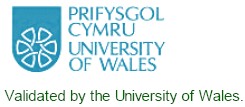
One of the best bits of news recently was the downfall of Matthias Rath. He’s the man who peddled vitamin pills for AIDS in Africa, and encouraged the AIDS denialists in the South African government. Thabo Mbeki and his Health Minister, Mrs Beetroot, have gone now, thank heavens.
Rath was one of the best illustrations of the murderous effect of selling ineffective treatments. The fact that nobody in the “nutritional therapy” industry has uttered a word of condemnation for this man illustrates better than anything one can imagine the corrupt state of “nutritional therapy”. The people who kept silent include the British Association of Nutritional Therapists (BANT).
It might be surprising, then, to find the Northern College of Acupuncture proudly adding a course in alternative nutrition to its courses in acupuncture (now known to be a theatrical placebo) and Chinese herbal medicine (largely untested and sometimes toxic). It might be even more surprising to find the boast that the course is validated by the University of Wales. It seemed a good idea to find out a bit more about how this came about. Thanks to the Freedom of Information Act, some interesting things can be discovered.
Polly Toynbee’s superb article, Quackery and superstition – available soon on the NHS, written in January 2008, mentioned diplomas and degrees in complementary therapies offered by, among others, the University of Wales. This elicited a letter of protest to Toynbee from the Vice-Chancellor of the University of Wales, Professor Marc Clement BSc, PhD, MInstP, CEng,CPhys,FIET. He invited her to visit the university to see their “validation and monitoring procedures (including the University’s very specific guidelines on health studies disciplines”.
So let’s take a look at these validation procedures and guidelines.
The validation process
The Northern College of Acupuncture submitted a 148 page proposal for the course in October 2007. The document has all the usual edu-bollocks jargon, but of course doesn’t say much about clinical trials, though it does boast about an unblinded trial of acupuncture published in 2006 which, because of lack of appropriate controls, served only to muddy the waters. : This submission was considered by the University’s validation committee last December.

|
The whole validation document is only four pages long [download it]. The most interesting thing about it is that the words ‘evidence’ or ‘critical’ do not occur in it a single time. It has all the usual bureaucratic jargon of such documents but misses entirely the central point.
Does that mean that the University of Wales doesn’t care about evidence or critical thinking? Well, not on paper. Two years previously a short document called Health Studies Guidelines had been written by Dr Brian Spriggs (Health Studies Validation Consultant, since retired) for the Health Studies Committee, and it was approved on 21 April 2005. It starts well.
“Degrees in the Health Studies field are expected to promote an understanding of the importance of the scientific method and an evidence-base to underpin therapeutic interventions and of research to expand that base.”
It even goes on to say that a BSc degree in homeopathy is “unacceptable”. Don’t get too excited though, because it also says that acupuncture and Chinese herbal stuff is quite OK. How anyone can imagine they live up to the opening sentence beats me. And it gets worse. It says that all sorts of rather advanced forms of battiness are OK if they form only part of another degree. They include Homeopathy, Crystal therapy. Dowsing, Iridology; Kinesiology, Radionics, Reflexology, Shiatsu, Healing, and Maharishi Ayurvedic Medicine.
Dowsing? Crystal therapy? Just let me remind you. We are living in 2008. It is easy to forget that when ploughing through all this new age junk.
The Validation Handbook of Quality Assurance: Health Studies (2007) runs to an astonishing 256 pages [download the whole thing]. On page 12 we find the extent of the problem.
“The University of Wales validates a number of schemes in the Health Studies field. At the current time we have undergraduate and/or postgraduate degree schemes in Acupuncture, Animal Manipulation, Chiropractic, Herbal Medicine, Integrative Psychotherapy, Osteopathy, Osteopathic Studies, Traditional Chinese Medicine and Regulatory Affairs, both in the UK and overseas.”
That sounds pretty shocking. Further down on page 12, though, we find this.
“Degrees in the Health Studies field are expected to promote an understanding of the importance of the scientific method and an evidence-base to underpin therapeutic interventions and of research to expand that base. The mission is to promote and require the critical evaluation of the practices, doctrines, beliefs, theories and hypotheses that underlie the taught therapeutic measures of the discipline.”
They are indeed fine words. The problem is that I can detect no sign in the submission, nor in its consideration by the validation committee, that any attempt whatsoever was made to ensure that the course complied with these requirements.
The only sign of concern I could detect of any concern about the quality of what was being taught came in a minute to a meeting of the Health Studies Committee meeting on 24th April 2008.
“Members received a copy of an article entitled Quackery and superstition available soon on the NHS which appeared in The Guardian newspaper in January 2008, and a copy of the Vice- Chancellors response. Members agreed that this article was now historical but felt that if/when the issue were to arise again; the key matter of scientific rigour should be stressed. The Committee agreed that this was the most critical element of all degree schemes in the University of Wales portfolio of health studies schemes. It was felt it would be timely to re-examine the schemes within the portfolio as well as the guidelines for consideration of Health Studies schemes at the next meeting. The Committee might also decide that Institutions would be required to include literature reviews (as part of their validation submission) to provide evidence for their particular profession/philosophy. It was agreed that the guidelines would be a vital document in the consideration of new schemes and during preliminary visits to prospective Institutions. “
The Press Office had passed Polly Toynbee’s article to them. Curiously the Health Studies Committee dismissed it as “historical”, simply because it was written three months earlier. That is presumably “historical” in the sense that the public will have forgotten about it, rather than in the sense that the facts of the matter have changed since January. So, at least for the nutrition degree, Toynbee’s comments were simply brushed under the carpet.
After a few cosmetic changes of wording the validation was completed on 16th January 2008. For example the word “diagnosis” was removed in 43 places and “rewritten in terms of evaluation and assessment”. There was, needless to say, no indication that the change in wording would change anything in what was taught to students.
You may think that I am being a bit too harsh. Perhaps the course is just fine after all? The problem is that the submission and the reaction of the validation committee tell you next to nothing about what actually matters, and that is what is taught. There is only a vague outline of that in the submission (and part of it was redacted on the grounds that if it were made public somebody might copy ;it. Heaven forbid).
That is why I have to say, yet again, that this sort of validation exercise is not worth the paper it’s written on.
How can we find out a bit more? Very easily as it happens. Just Google. What matters is not so much formal course outlines but who teaches them.
The nutrition course
The title of the course is just “Nutrition”, not ‘Nutritional Therapy’ or ‘Alternative Nutrition’. That sounds quite respectable but a glance at the prospectus shows immediately that it is full-blown alternative medicine.
Already in July 2007, the glowing press releases for the course had attracted attention from the wonderfully investigative web site HolfordWatch. I see no sign that the validation committee was aware of this. But if not, why not? I would describe is as dereliction of academic duty.
“This pioneering course is unique in that it is firmly rooted in both Western nutritional science and naturopathic medicine and also covers concepts of nutrition within traditional Chinese, Japanese, Tibetan and Ayurvedic medicine.
This means that graduates will gain comprehensive understanding of both modern scientific knowledge and ancient wisdom concerning nutrition and dietetics.”
Ancient wisdom, of course, means something that your are supposed to believe though there is no good reason to think it’s true. In the end, though, almost the only thing that really matters about any course is who is running it. The brochure shows that all of the people are heavily into every form of alternative nuttiness.
Course Director and Tutor: Jacqueline Young nutritionist, naturopath, clinical psychologist and Oriental medical practitioner
Nutrition Tutors:
Elaine Aldred (qualified as a chiropractor with the Anglo European Chiropractic College, as an acupuncturist with the British College of Acupuncture and as a Western Medical Herbalist with the College of Phytotherapy. She recently also qualified in Chinese herbal medicine with the Northern College of Acupuncture.)
Sue Russell (3 year diploma in nutritional therapy at the Institute of Optimum Nutrition. She currently practises as a nutritional therapist and also works part-time as a manager at the Northern College of Homeopathic Medicine.)
Anuradha Sharma (graduated as a dietician from Leeds Metropolitan University in 2002 and subsequently completed a Naturopathy certificate and a post-graduate diploma in acupuncture).
Guest Lecturers include : Dr John Briffa, Professor Jane Plant, M.B.E. (a geochemist turned quack), and, most revealingly, none other than the UK’s most notorious media celebrity and pill peddler, Patrick Holford.
So much has been written about Holford’s appalling abuse of science, one would have thought that not even a validation committee could have missed it.
“The course has been created by Jacqueline Young“, so let’s look a bit further at her track record.
Jacqueline Young has written a book, ‘Complementary Medicine for Dummies’ [Ed: ahem shouldn’t that be Dummies for Complementary Medicine?]. You can see parts of it on Google Books. Did the validation committee bother to look at it? As far as I can tell, the words ‘randomised’ or ‘clinical trial’ occur nowhere in the book.
The chapter on Tibetan medicine is not very helpful when it comes to evidence but for research we are referred to the Tibetan Medical and Astrology Institute. Guess what? That site gives no evidence either. So far not a single university has endorsed Astrology (there is a profitable niche there for some vice-chancellor).
Here are few samples from the book. The advice seems to vary from the undocumented optimism of this

Well researched? No. Safe? Nobody knows. Or this

Mandarin peel prevents colds and flu? Old wive’s tale. Then there are things that verge on the weird, like this one
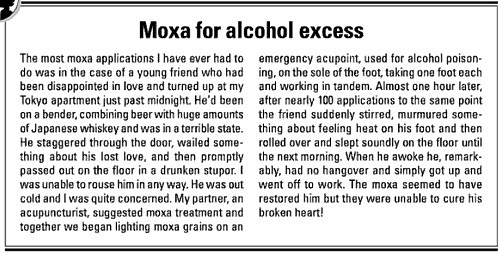
or the deeply bizarre like this
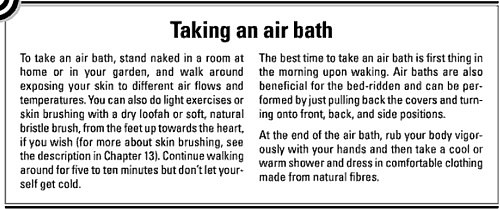
The problem of Jacqueline Young’s fantasy approach to facts was pointed out at least as far back as 2004, by Ray Girvan., who wrote about it again in May 2005. The problems were brought to wider attention when Ben Goldacre wrote two articles in his Badscience column, Imploding Researchers (September 2005), and the following week, Tangled Webs.
“we were pondering the ethics and wisdom of Jacqueline Young dishing out preposterous, made-up, pseudoscientific nonsense as if it was authoritative BBC fact, with phrases such as: “Implosion researchers have found that if water is put through a spiral its electrical field changes and it then appears to have a potent, restorative effect on cells.” “
and later
“Take this from her article on cranial osteopathy, riddled with half truths: “Sutherland found that the cranial bones (the skull bones encasing the brain) weren’t fused in adulthood, as was widely believed, but actually had a cycle of slight involuntary movement.” In fact the cranial bones do fuse in adulthood.
She goes on: “This movement was influenced by the rhythmic flow of cerebrospinal fluid (the nourishing and protective fluid that circulates through the spinal canal and brain) and could become blocked.” There have now been five studies on whether “cranial osteopaths” can indeed feel these movements, as they claim, and it’s an easy experiment to do: ask a couple of cranial osteopaths to write down the frequency of the rhythmic pulses on the same person’s skull, and see if they give the same answer. They don’t. A rather crucial well-replicated finding to leave out of your story.
That was in 2005 and since then all of Young’s “preposterous, made-up, pseudoscientific nonsense” (along with most of the other stuff about junk medicine) has vanished from the BBC’s web site, after some people with a bit of common sense pointed out what nonsense it was. But now we see them resurfacing in a course validated by a serious university. The BBC had some excuse (after all, it is run largely by arts graduates). I can see no excuses for the University of Wales.
Incidentally, thanks to web archive you can still read Young’s nonsense, long after the BBC removed it. Here is a quotation.
“Implosion researchers have found that if water is put through a spiral its ,field changes and it then appears to have a potent, restorative effect on cells. In one study, seedlings watered with spiralised water grew significantly faster, higher and stronger than those given ordinary water.”
The vice-chancellor of the University of Wales, Marc Clement, is a physicist (Department of Electrical and Electronic Engineering), so can he perhaps explain the meaning of this?
Selection committees for jobs (especially senior jobs) and validation committees for courses, might make fewer mistakes if they didn’t rely so much on formal documents and did a little more investigation themselves. That sort of thing is why the managerial culture not only takes a lot more time, but also gives a worse result.
It would have taken 10 minutes with Google to find out about Young’s track record, but they didn’t bother. As a result they have spent a long time producing a validation that isn’t worth the paper it’s written on. That makes the University of Wales a bit of a laughing stock. Worse still, it brings science itself into disrepute.
Follow-up
What does the University of Wales say? So far, nothing. Last week I sent brief and polite emails to Professor Palastanga and to Professor Clement to try to discover whether it is true that the validation process had indeed missed the fact that the course organiser’s writings had been described as “preposterous, made-up, pseudoscientific nonsense” in the Guardian.
So far I have had no reply from the vice-chancellor, but on .26 October I did get an answer from Prof Palastaga.
| As regards the two people you asked questions about – J.Young – I personally am not familiar with her book and nobody on the validation panel raised any concerns about it. As for P.Holford similarly there were no concerns expressed about him or his work. In both cases we would have considered their CV’s as presented in the documentation as part of the teaching team. In my experience of conducting degree validations at over 16 UK Universities this is the normal practice of a validation panel. |
I have to say this reply confirms my worst fears. Validation committees such as this one simply don’t do their duty. They don’t show the curiosity that is needed to discover the facts about the things that they are meant to be judging. How could they not have looked at the book by the very person that they are validating? After all that has been written about Patrick Holford, it is simply mind-boggling that the committee seems to have been quite unaware of any of it.
It is yet another example of the harm done to science by an unthinking, box-ticking approach.
Pharmacology. A Handbook for Complementary Healthcare Professionals
Elsevier were kind enough to send me an inspection copy of this book, which is written by one of the nutrition course tutors, Elaine Aldred. She admits that pharmacology is “considered by most students to be nothing more that a ‘hoop-jumping’ exercise in the process of becoming qualified”. She also says. disarmingly. that “I was certainly not the most adept scientist at school and found my university course a trial”.
The book has all the feel of a cut and paste job. It is mostly very simple (if not simplistic). though for no obvious reason it starts with a long (and very amateur) discussion of chemical bonding Then molecules are admitted to be indivisible (but, guess what, the subject of homeopathy is avoided). There is a very short section on ion channels, though, bizarrely, it appears under the heading “How do drugs get into cells?”. Since the author is clearly not able to make the distinction between volts and coulombs, the discussion is more likely to confuse the reader than to help.
Then a long section on plants. It starts of by asserting that “approximately a quarter of prescription drugs contain at least one chemical that was originally isolated and extracted from a plant”.. This cannot be even remotely correct. There are vast tables showing complicated chemical structures, but the usual inadequate
list of their alleged actions This is followed by a quick gallop through some classes of conventional drugs, illustrated again mainly by chemical structures not data. Hormone replacement therapy is mentioned, but the chance to point out that it is one of the best illustrations of the need for RCTs is missed.
The one thing that one would really like to see in such a book is a good account of how you tell whether or not a drug works in man. This is relegated to five pages at the end of the book, and it is, frankly, pathetic. It
is utterly uncritical in the one area that matters more than any other for people who purport to treat patients. All you get is a list of unexplained bullet points.
If this book is the source of the “scientific content” of the nutrition course, things are as bad as we feared.
Today is a good day for anyone who deplores dangerous confidence tricksters. In particular it is a good day for Ben Goldacre, and for the Guardian which defended him at potentially enormous expense.
| Matthias Rath, the Dutch (or is it German) vitamin salesman has dropped his libel action against the Guardian. He is the man who is, without doubt, responsible for many deaths form AIDS in Africa, as a result of peddling vitamin pills as cures. The action was taken after Goldacre said, in the Guardian, that Rath aggressively sells his message to Aids victims in South Africa that Rath vitamin pills are better than medication”. | 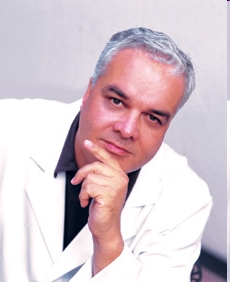 |
Here is some of what has appeared already today
Fall of the doctor who said his vitamins would cure Aids – from The Guardian, with a video of the villain.
Goldacre’s Badscience blog article on his victory .
Profile of Zackie Achmat – from The Guardian, Mr Achmat is the founder of the Treatment Action Campaign , instrumental in exposing Rath.
Extract from witness statements from the defence in the trial .
And a lot of publicity from Gimpyblog (“Ben Goldacre and The Guardian triumph over murderous Matthias Rath”), Holfordwatch , Quackometer and jdc325 blogs.
Then more in the Guardian the next day, Chris McGreal investigates the Rath Foundation
Nutritional therapist?
Let’s be clear about what the words mean. Nutritional therapists are not like dietitians, and they are not like nutritionists. Nutritional therapists are solidly in the camp of alternative medicine practitioners, Don’t
take my word for it. They say so themselves.
“For nutritional therapists (who practise Complementary and Alternative Medicine) optimum nutrition encompasses individual prescriptions for diet and lifestyle in order to alleviate or prevent ailments and to promote optimal gene expression through all life stages. Recommendations may include guidance on natural detoxification, procedures to promote colon health, methods to support digestion and absorption, the avoidance of toxins or allergens and the appropriate use of supplementary nutrients, including phytonutrients.”
They love to use imaginary words like “detoxification”, and, much more dangerously, they love to pretend that they can cure diseases by changes in diet. As long as you buy from them a stack of expensive “supplement” pills, of course. That means they are selling medicines, but by pretending they are selling food supplements they manage to evade the law that requires medicines to be safe and effective. That will not be so easy under new legislation though, and we can look forward to a few prosecutions soon.
Guess who runs an “Honours BSc degree” in Nutritional Therapy. No prizes for realising it is the UK’s leading university purveyor of woo.
The University of Westminster
On their web site we learn that the Course Leader is Heather Rosa, and the Deputy Course Leader is Val Harvey. Harvey qualified in the subject at the Institute of Optimum Nutrition, the private college run by none other than the famous pill-peddler, Patrick Holford, about whom so very much has been written (try Holfordwatch, or the masterly chapter in Goldacre’s Bad Science)
We don’t know much about what is taught on the Nutritional Therapy course because the University of Westminster has refused repeated requests to say (but watch this space).. One can only assume that, whatever it is, they are not very proud of it. It seems a little unlikely that they will go as far as Matthias Rath and claim to cure AIDS -we’ll just have to wait and see. Meanwhile we can get an inkling by looking elsewhere.
Course leader, Heather Rosa, pops up for example, on the expert panel of a web site called Supplements Compared.com. “Supplements Compared is designed to help you find the best dietary supplement product for your health needs.” And what sort of advice do you find there? Try the page that compares 10 brands of CoQ10 (that is the stuff I wrote about recently, in “Boots reaches new level of dishonesty with CoQ10 promotion” – their advertising was deemed improper by the ASA ). It isn’t a recommended treatment for anything at all, but you certainly wouldn’t guess that from what is written by the ‘expert panel’. The winners are, according to the ‘expert panel’, Boots’ CoQ10 and Holland and Barrett’s CoQ10. Winners? Perhaps the explanation for that comes elsewhere, under “How are we funded?”. “Manufacturers who are awarded “best product” and “worth a look” are given the opportunity to promote this fact throughout the site for an additional fee.”. Well well.
Deputy Course leader, Val Harvey has her own web site and business (I do hope thar Westminster does not pay these people a full time salary too). What can we glean from there? It has the usual scare tactics “Why
you are at risk?“. Never fear; buy enough vitamin pills and you’ll be saved.
Her home page makes some pretty drastic claims.
“Potential health benefits of your nutritional programme
An appropriate Nutritional Programme can benefit many conditions including:
Allergies
Arthritis
Asthma
Bloating, indigestion
Chronic degenerative diseases
Chronic fatigue, ME
Constipation, diarrhoea
Cystitis
Depression, mood swings
Digestive or bowel problems
Eczema, psoriasis, other skin problems
Food sensitivities
Frequent infections
Hormone imbalanceHypertension or elevated cholesterol
Irritable bowel syndrome
Low energy
Menopausal symptoms
Migraines, headaches
Parasitic and fungal infections
Pre-conceptual issues
Premenstrual syndrome (PMS)
Sinus congestion
Stress
Thrush
Weight problems
and many others ….
These are just some of the wide range of health problems that may be helped by nutritional therapy. Even those who consider themselves well and healthy may be able to enhance their physical and mental health, as well as their performance, including athletic performance, by improving their nutrition.”
There is, in my view, not the slightest bit of good evidence that swallowing vitamin pills can benefit most of these conditions.
But at least the list doesn’t contain AIDS, so is all this really relevant to the case of Matthias Rath?
Yes, I believe it is. The University of Westminster may well not support the views of Matthias Rath (they won’t say), but we have heard no choruses of protests about him from any nutritional therapists, as far as I’m aware. There is no mention of him at all on the web site of the British Association of Nutritional Therapists (BANT), the UK club for these people. BANT, by the way, has a rather curious code of ethics. It allows its members to take undisclosed financial kickbacks for the pills they prescribe to patients. If doctors were caught doing that they’d be struck off the register.
It is the existence of degrees in subjects like “nutritional therapy” that gives the subject a spurious air of respectability which allows seriously dangerous people like Rath to flourish with very little criticism. In an indirect way, the vice-chancellors who allow it to flourish (and Universities UK who do nothing about it) must bear some small part of the responsibility for the deaths of thousands of people from AIDS.
It is about time they did something about it.
Follow-up
ANH. The first reaction from the supplement-peddling industry comes from the Alliance for Natural Health on 16th September. It contains not one word of condemnation for Rath’s murderous activities. It’s hard to believe how low they will sink.
The Prince’s Foundation for Integrated Health remains totally silent about Rath. HRH’s concern for health seems to dry up if things don’t suit his views.
The British Association of Nutritional Therapists shows it’s total irresponsibility after a letter was sent to them to ask about their reaction. Their answer , on jdc325’s weblog was “The association has no opinion to offer on Dr Raths vitamin trials.”.
There have been some really excellent books about quackery this year. This isn’t one of them, because
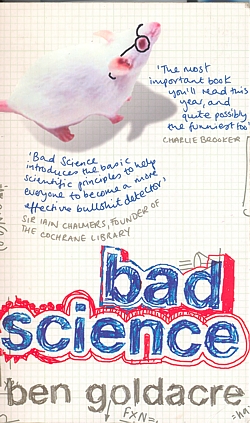 |
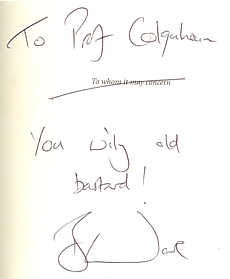
Nice dedication uh? |
it is about a lot more than quackery It is about the scientific method in general. and in particular about how often it is misunderstood by journalists. Abuse of evidence by the pharmaceutical industry is treated just as harshly as abuse of evidence by homeopaths and you get the low-down on both.
“More importantly, you will also see how a health myth can be created, fostered and maintained by the alternative medicine industry using all the same tricks on you, the public, which big pharma uses on doctors. This is about something much bigger than homeopathy.” (p.28)
Sir Iain Chalmers, a founder of the Cochrane Collaboration , co-author of the best lay text on evidence says: “Bad Science introduces the basic scientific principles to help everyone become a more effective bullshit detector”. And there is no more invaluable skill than being a bullshit detector.
Chalmers says also “Ben Goldacre has succeeded where the ‘public engagement in science’ organisations have so signally failed.” That is exactly right. ‘Public engagement’ has rapidly become bureaucratised, and at its worst, is no better than a branch of the university’s marketing department. This sort of public engagement corrupts as much as it enlightens. Goldacre enlightens, and he also makes you laugh.
In the introduction, Goldacre says
“You cannot reason people out of positions that they didn’t reason themselves into.” (p xii)
It’s a nice point, but the rest of the book makes a magnificent attempt to do just that.
There is quite a lot about medicine, of course, that’s his job, after all. But it isn’t all quackery by a long chalk Quackery is merely a good hook to hang the arguments on about how you distinguish what’s true from what isn’t. That’s partly because quacks make every mistake known to mankind (sometimes through ignorance, sometimes just to boost sales), and partly just because it is a topic that interests people, and with which they are bombarded every day I feel exactly the same. If I were to talk about the statistics of single ion channels, nobody would read it (big mistake -it’s fascinating), but if one can use the case of honey versus cough medicine to explain the analysis of variance, there is a chance that someone might find it interesting.
As much as anything, Goldacre’s book is about C.P. Snow’s two cultures. The chapters on the distortion and trivialisation of science in the media are just terrific.
“My basic hypothesis is this: the people who run the media are humanities graduates with little understanding of science, who wear their ignorance as a badge of honour. Secretly, deep down, perhaps they resent the fact that they have denied themselves access to the most significant developments in the history of Western thought from the past two hundred years.” Chapter 11, p. 207
“.. . . here is the information I would like from a newspaper to help me make decisions about my health, when reporting on a risk: I want to know who you’re talking about (e.g. men in their fifties): I want to know what the baseline risk is (e.g. four men out of a hundred will have a heart attack over ten years); and I want to know what the increase in risk is , as a natural frequency [not as relative risk] (two extra men out of that hundred will have a heart attack over ten years). I also want to know exactly what’s causing that increase in risk -an occasional headache pill or a daily tub full of pain-relieving medication for arthritis. Then I will consider reading your newspapers again, instead of blogs which are written by people who understand research , and which link reliably back to the original academic paper, so that I can double check their précis when I wish. ” (p. 242)
I detect some ambiguity in references to things that aren’t true. Sometimes there is magnanimity. At other times he is a grade one kick-ass ninja. For example
I can very happily view posh cosmetics -and other forms of quackery -as a special, self-administered, voluntary tax on people who don’t understand science properly (p. 26)
Of course nobody wants to ban cosmetics, or even homeopathy. But a lot of bad consequences flow from being over-tolerant of lies if you take it too far (he doesn’t). The lying dilemma and the training dilemma are among them. Some unthinking doctors will refer troublesome patients to a reflexologist. That gets the worried-well out of their surgery but neglects the inevitable consequence that Human Resources box-ticking zombies will then insist on having courses that teach the big toe is connected to the kidney (or whatever) so that reflexologists can have an official qualification in mystical mumbo-jumbo.
Is there anything missing from the book? Well inevitably. There are plenty of villains among the peddlers of nutri-bollocks, and in the media. But there isn’t much about the people who seem to me to be in some ways even worse. What about the black-suited men and women in the Ministry of Health and in some vice-chancellors’ chairs who betray their institutions and betray the public through some unfathomable
mixture of political correctness, scientific ignorance and greed? What about the ludicrous behaviour of quangos like Skills for Health? You have to wait right to the end of the book to hear about universities. But when it comes, it is well worth the wait.
“I’m not surprised that there are people with odd ideas about medicine, or that they sell those ideas. But I am spectacularly, supremely, incandescently unimpressed when a a university starts to offer BSc science courses in them.” (p. 317)
It’s almost worth buying Ben Goldacre’s book for that sentence alone.
This book is a romp through the folly, greed and above all the ignorance of much in our society. It’s deeply educational. And it makes you laugh. What more could you want?
During the last year, there has been a very welcome flurry of good and informative books about alternative medicine. They are all written in a style that requires little scientific background, even the one that is intended for medical students.
CAM, Cumming | Trick or Treatment | Snake Oil Science |
Testing treatments | Suckers | Healing, Hype or Harm
I’ll start with the bad one, which has not been mentioned on this blog before.
Complementary and Alternative medicine. An illustrated text.
by Allan D. Cumming, Karen R. Simpson and David Brown (and 12 others). 94 pages, Churchill Livingstone; 1 edition (8 Dec 2006).
| The authors of this book sound impressive
Allan Cumming, BSc(Hons), MBChB, MD, FRCP(E), Professor of Medical Education and Director of Undergraduate Learning and Teaching, and Honorary Consultant Physician, College of Medicine and Veterinary Medicine, University of Edinburgh, Edinburgh, UK; Karen Simpson, BA(Hons), RN, RNT, Fellow in Medical Education, College of Medicine and Veterinary Medicine David Brown, MBChB, DRCOG, General Practitioner, The Murrayfield Medical Centre, and Honorary Clinical Tutor, University of Edinburgh |
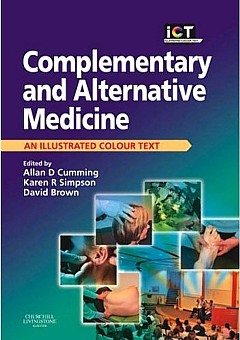 |
Sadly, this is a book so utterly stifled by political correctness that it ends up saying nothing useful at all. The slim volume is, I have to say, quite remarkably devoid of useful information. Partly that is a result of out-of-date and selective references (specially in the chapters written by alternative practitioners),
But the lack of information goes beyond the usual distortions and wishful thinking. I get the strong impression is that it results not so much for a strong commitment to alternative medicine (at least by Cumming) as from the fact that the first two authors are involved with medical education. It seems that they belong to that singularly barmy fringe of educationalists who hold that the teacher must not give information to s student for fear of imparting bias. Rather the student must be told how to find out the information themselves. There is just one little problem with this view. It would take about 200 years to graduate in medicine.
There is something that worries me about medical education specialists. Just look at the welcome given by Yale’s Dean of Medical Education, Richard Belitsky, to Yale’s own division of “fluid concepts of evidence”, as described at Integrative baloney @ Yale, and as featured on YouTube. There are a lot of cryptic allusions to alternative forms of evidence in Cumming’s book too, but nothing in enough detail to be useful to the reader.
What should a book about Alternative medicine tell you? My list would look something like this.
- Why people are so keen to deceive themselves about the efficacy of a treatment
- Why it is that are so often deceived into thinking that something works when it doesn’t
- How to tell whether a medicine works better than placebo or not,
- Summaries of the evidence concerning the efficacy and safety of the main types of alternative treatments.
The Cumming book contains chapters with titles like these. It asks most of the right questions, but fails to answer any of them. There is, time and time again, the usual pious talk about the importance of evidence, but then very little attempt to tell you what the evidence says. When an attempt is made to mention evidence, it is usually partial and out of date. Nowhere are you told clearly about the hazards that will be encountered when trying to find out whether a treatment works.
| The usual silly reflexology diagram is reproduced in Cumming’s introductory chapter, but with no comment at all, The fact that it is obviously total baloney is carefully hidden from the reader.. What is the poor medical student meant to think when they perceive that it is totally incompatible with all the physiology they have learned? No guidance is offered. | 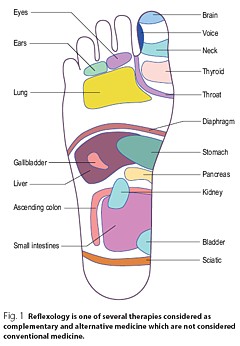 |
| You will look in vain for a decent account of how to do a good randomised controlled trial, though you do get a rather puerile cartoon, The chapter about evidence is written by a librarian. Since the question of evidence is crucial, this is a fatal omission. | 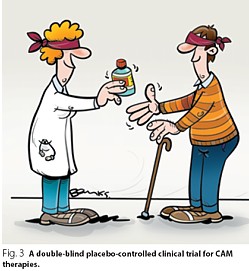 |
Despite the lack of presentation of evidence that any of it works, there seems to be an assumption throughout the book that is is desirable to integrate alternative medicine into clinical practice. In Cumming’s chapter (page 6) we see

Since it would not be in the interests of patients to integrate treatments that don’t work with treatments that do work, I see only two ways to explain this attitude. Either the authors have assumed than most alternative methods work (in which case they haven’t read the evidence), or they think integration is a good idea even if the treatment doesn’t work. Neither case strikes me as good medical education.
The early chapters are merely vague and uninformative. Some of the later chapters are simply a disgrace.
Most obviously the chapter on homeopathy is highly selective and inaccurate, That is hardly surprising because it is was written by Thomas Whitmarsh, a consultant physician at Glasgow Homeopathic Hospital (one that has still survived). It has all the usual religious zeal of the homeopath. I honestly don’t know whether people like Whitmarsh are incapable of understanding what constitutes evidence, or are simply too blinded by faith to even try. Since the only other possibility is that they are dishonest, I suppose it must be one of the former.
The chapter on “Nutritional therapy” is also written by a convert and is equally misleading piece of special pleading.
The same is true of the chapter on Prayer and Faith Healing. This chapter reproduces the header of the Cochrane Review on “Intercessory prayer for the alleviation of Ill Health”, but then proceeds to ignore entirely its conclusion “Most of the studies show no real differences”).
If you want to know about alternative medicine, don’t buy this book. Although this book was written for medical students, you will learn a great deal more from any of the following books, all of which were written for the general public.
Trick or Treatment
by Simon Singh and Edzard Ernst, Bantam Press, 2008
| Simon Singh is the author of many well-known science books, like Fermat’s Last Theorem. Edzard Ernst is the UK’s first professor of complementary and alternative medicine.
Ernst, unlike Cumming et. al is a real expert in alternative medicine. He practised it at an early stage in his career and has now devoted all his efforts to careful, fair and honest assessment of the evidence. That is what this book is about. It is a very good account of the subject and it should be read by everyone, and certainly by every medical student. |
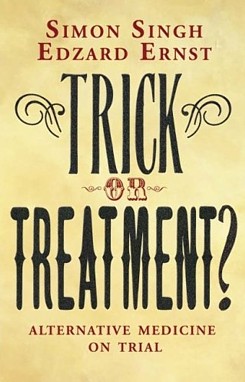 |
Singh and Ernst follow the sensible pattern laid out above, The first chapter goes in detail into how you distinguish truth from fiction (a little detail often forgotten in this area).
The authors argue, very convincingly, that the development of medicine during the 19th and 20th century depended very clearly on the acceptance of evidence not anecdote. There is a fascinating history of clinical trials, from James Lind (lemons and scurvy), John Snow and the Broad Street pump, Florence Nightingale’s contribution not just to hygiene, but also to the statistical analysis that was needed to demonstrate the strength of her conclusions (she became the first female member of the Royal Statistical Society, and had studied under Cayley and Sylvester, pioneers of matrix algebra).
There are detailed assessments of the evidence for acupuncture, homeopathy, chiropractic and herbalism, and shorter synopses for dozens of others. The assessments are fair, even generous in marginal cases.
Acupunture. Like the other good books (but not Cumming’s), it is pointed out that acupuncture in the West is not so much the product of ancient wisdom (which is usually wrong anyway), but rather a product of Chinese nationalist propaganda engineered by Mao Tse-tung after 1949. It spread to the West after Nixon’s visit Their fabricated demonstrations of open heart surgery under acupuncture have been known since the 70s but quite recently they managed again to deceive the BBC It was Singh who revealed the deception. The conclusion is ” . . . this chapter demonstrates that acupuncture is very likely to be acting as nothing more than a placebo . . . ”
Homeopathy. “hundreds of trials have failed to deliver significant or convincing evidence to support the use of homeopathy for the treatment of any particular ailment. On the contrary, it would be to say that there is a mountain of evidence to suggest that homeopathic remedies simply do not work”.
Chiropractic. Like the other good books (but not Cumming’s) there is a good account of the origins of chiropractic (see, especially, Suckers). D.D. Palmer, grocer, spiritual healer, magnetic therapist and fairground quack, finally found a way to get rich by removing entirely imaginary ‘subluxations’. They point out the dangers of chiropractic (the subject of court action), and they point out that physiotherapy is just as effective and safer.
Herbalism. There is a useful table that summarises the evidence. They conclude that a few work and most don’t Unlike homeopathy, there is nothing absurd about herbalism, but the evidence that most of them do any good is very thin indeed.
| “We argue that it is now the time for the tricks to stop, and for the real treatments to take priority. In the name of honesty, progress and good healthcare, we call for scientific standards, evaluation and regulation to be applied to all types of medicine, so that patients can be confident that they are receiving treatments that demonstrably generate more harm than good.” |
Snake Oil Science, The Truth about Complementary and Alternative Medicine.
R. Barker Bausell, Oxford University Press, 2007
Another wonderful book from someone who has been involved himself in acupuncture research, Bausell is a statistician and experimental designer who was Research Director of a Complementary and Alternative Medicine Specialised Research Center at the University of Maryland.
This book gives a superb account of how you find out the truth about medicines, and of how easy it is to be deceived about their efficacy.
I can’t do better than quote the review by Robert Park of the American Physical Society (his own book, Voodoo Science, is also excellent)
| “Hang up your lantern, Diogenes, an honest man has been found. Barker Bausell, a biostatistician, has stepped out of the shadows to give us an insider’s look at how clinical evidence is manipulated to package and market the placebo effect. Labeled as ‘Complementary and Alternative Medicine’, the placebo effect is being sold, not just to a gullible public, but to an increasing number of health professionals as well. Bausell knows every trick and explains each one in clear language” | 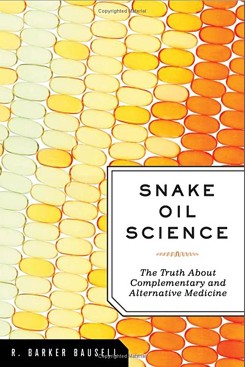 |
Bausell’s conclusion is stronger than that of Singh and Ernst.
“There is no compelling, credible scientific evidence to suggest that any CAM therapy benefits any medical condition or reduces any medical symptom (pain or otherwise) better than a placebo”.
Here are two quotations from Bausell that I love.
[Page 22] ” seriously doubt, however, that there is a traditional Chinese medicine practitioner anywhere who ever stopped performing acupuncture on an afflicted body in the presence of similarly definitive negative evidence. CAM therapists simply do not value (and most cases, in my experience, do not understand) the scientific process”
And even better,
[Page39] “But why should nonscientists care one iota about something as esoteric as causal inference? I believe that the answer to this question is because the making of causal inferences is part of our job description as Homo Sapiens.”
Testing Treatments: Better Research for Better Healthcare
by Imogen Evans, Hazel Thornton, Iain Chalmers, British Library, 15 May 2006
You don’t even need to pay for this excellent book (but buy it anyway, eg from Amazon). If you can’t afford, £15 then download it from the James Lind Library.
| This book is a unlike all the others, because it is barely mentions alternative medicine. What it does, and does very well, is to describe he harm that can be done to patients when they are treated on the basis of guesswork or ideology, rather than on the basis of proper tests. This, of course, is true whether or not the treatment is labelled ‘alternative’.
It is worth noting that one of the authors of this book is someone who has devoted much of his life to the honest assessement of evidence, Sir Iain Chalmers, one of the founders of the Cochrane Collaboration , and Editor of the James Lind Library . |
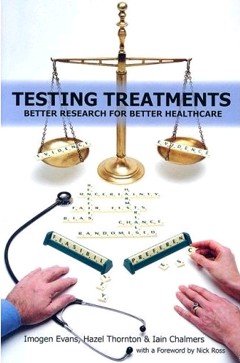 |
A central theme is that randomised double blind trial are essentially the only way to be sure you have the right answer. One of the examples that the authors use to illustrate this is Hormone Replacement Therapy (HRT). For over 20 years, women were told that HRT would reduce their risk of heart attacks and strokes. But when, eventually, proper randomised trials were done, it was found that precisely the opposite was true. The lives of many women were cut short because the RCT had not been done,
The reason why the observational studies gave the wrong answer is pretty obvious. HRT was used predominantly by the wealthier and better-educated women. Income is just about the best predictor of longevity. The samples were biassed, and when a proper RCT was done it was revealed that the people who used HRT voluntarily lived longer despite the HRT, not because of it. It is worth remembering that there are very few RCTs that test the effects of diet. And diet differs a lot between rich and poor people. That, no doubt, is why there are so many conflicting recommendations about diet. And that is why “nutritional therapy” is little more than quackery. Sadly, the media just love crap epidemiology. One of the best discussions of this topics was in Radio 4 Programme. “The Rise of the Lifestyle Nutritionists“, by Ben Goldacre.
One of the big problems in all assessment is the influence of money, in other words corruption, The alternative industry is entirely corrupt of course, but the pharmaceutical industry has been increasingly bad. Testing Treatments reproduces this trenchant comment.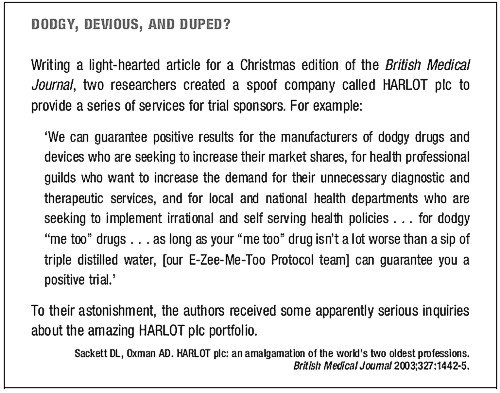
Suckers. How Alternative Medicine Makes Fools of Us All
Rose Shapiro, Random House, London 2008
| I love this book. It is well-researched, feisty and a thoroughly good read.
It was put well in the review by George Monbiot.
The chapters on osteopathy and chiropractic are particularly fascinating. |
 |
This passage describes the founder of the chiropractic religion.
“By the 1890s Palmer had established a magnetic healing practice in Davenport, Iowa, and was styling himself ‘doctor’. Not everyone was convinced as a piece about him in an 1894 edition of the local paper, the Davenport Leader, shows.”
A crank on magnetism has a crazy notion hat he can cure the sick and crippled with his magnetic hands. His victims are the eak-minded, ignorant and superstitious, those foolish people who have been sick for years and have become tired of the regular physician and want health by the short-cut method . . . he has certainly profited by the ignorance of his victims . . . His increase in business shows what can be done in Davenport, even by a quack”
Over 100 years later, it seems that the “weak-minded, ignorant and superstitious” include the UK’s Department of Health, who have given these quacks a similar status to the General Medical Council.
The intellectual standards of a 19th Century mid-western provincial newspaper leader writer are rather better than the intellectual standards of the Department of Health, and of several university vice-chancellors in 2007.
Healing Hype or Harm
Edited by Imprint Academic (1 Jun 2008)
Download the contents page
My own chapter in this compilation of essays, “Alternative medicine in UK Universities” is an extended version of what was published in Nature last year (I don’t use the term CAM because I don’t believe anything can be labelled ‘complementary’ until it has been shown to work). Download a copy if the corrected proof of this chapter (pdf).
| Perhaps the best two chapters, though, are “CAM and Politics” by Rose and Ernst, and “CAM in Court” by John Garrow.
CAM and politics gives us some horrifiying examples of the total ignorance of almost all politicians and civil servants about the scientific method (and their refusal to listen to anyone who does understand it). CAM in Court has some fascinating examples of prosecutions for defrauding the public. Recent changes in the law mean we may be seeing a lot more of these soon. Rational argument doesn’t work well very well with irrational people. But a few homeopaths in jail for killing people with malaria would probably be rather effective. |
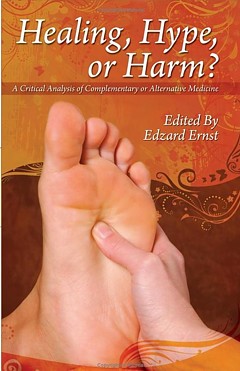 |
Follow-up
Healing, Hype or Harm has had some nice reviews, That isn’t so surprising from the excellent Harriet Hall at Science-Based Medicine. The introduction to my chapter was a fable about the replacemment of the Department of Physics and Astronomy by the new Department of Alternative Physics and Astrology. It was an unashamedly based on Laurie Taylor’e University of Poppleton column. Hall refers to it as “Crislip-style”, a new term to me. I guess the incomparable Laurie Taylor is not well-known in the USA, Luckily Hall gives a link to Mark Crislip’s lovely article, Alternative Flight,
“Americans want choice. Americans are increasingly using alternative aviation. A recent government study suggests that 75% of Americans have attempted some form of alternative flight, which includes everything from ultralights to falling, tripping and use of bungee cords.”
“Current airplane design is based upon a white male Western European model of what powered flight should look like. Long metal tubes with wings are a phallic design that insults the sensibilities of women, who have an alternative, more natural, emotional, way of understanding airplane design. In the one size fits all design of allopathic airlines, alternative designs are ignored and airplane design utilizing the ideas and esthetics of indigenous peoples and ancient flying traditions are derided as primitive and unscientific, despite centuries of successful use.”
Metapsychology Online Reviews doesn’t sound like a promising title for a good review of Healing, Hype or Harm, but in fact their review by Kevin Purday is very sympathetic. I like the ending.
“One may not agree with everything that is written in this book but it is wonderful that academic honesty is still alive and well.”
The extent to which irrationality has become established in US Medicine is truly alarming I wrote about Quackademics in the USA and Canada on my last trip to the USA, and on my May trip I visited Yale, where I decided to try a full frontal attack. [download the poster]

Several US blogs have written about this phenomenon. For example the incomparable Orac at the The Academic Woo Aggregator , and Dr RW (R.W. Donnell) , see particularly his articles on How did pseudoscience get admitted to medical school? and What is happening to our medical schools? Abraham Flexner is turning over in his grave. Excellent US stuff too at Science-based Medicine (try this and this). There is also a good analysis of what’s happening at Yale by Sandy Szwarc at Junkfood Science.
Remember that the terms ‘integrative’ and ‘complementary’ are euphemisms coined by quacks to make their wares sound more respectable, There is no point integrating treatments that don’t work with treatments that do work.
‘Integrative Medicine’ at Yale says, like all the others on the roll of shame, says “we aim to improve awareness and access to the best in evidence-based, comprehensive medical care available worldwide”. They all pay lip service to being “evidence based”, but there is just one snag. It is untrue. In almost all cases, the evidence is either negative or absent. But this does not put them off for a moment. The whole process is simply dishonest.
The evidence
The evidence has been summarised in several books recently, The following books are particularly interesting because they are all ‘views from the inside. Edzard Ernst is the UK’s first Professor of Complementary Medicine. Barker Bausell was research director of an NIH funded Complementary and Alternative Medicine Specialized Research Center at the University of Maryland.
The first two books go through the evidence fairly and carefully. They show no bias against alternative treatments (if anything, I’d say they are rather generous in cases of doubt).
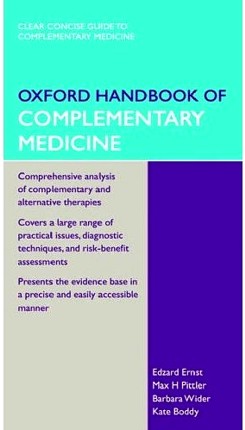 |
 |
For a first class US account try Barker Bausell’s Snake Oil Science
Bausell’s book gives an excellent account of how to test treatments properly, and of all the ways you can be fooled into thinking something works when it doesn’t. Bausell concludes
|
 |
| For an excellent account of how to find the truth, try Testing Treatments (Evans. Thornton and Chalmers). One of the authors, Iain Chalmers, is a founder of the Cochrane library and a world authotity on how to separate medical fact from medical myth. | 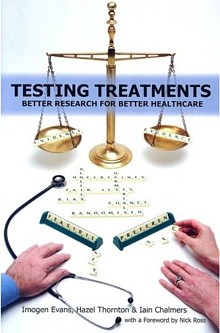 |
It can now be said with some certainty that the number of alternative treatments that have been shown to work better than placebo is very small, and quite possibly zero,
With that settled, what’s going on at Yale (and many others on the roll of shame)?
David L. Katz, MD, MPH, FACPM, FACP, is founder and director of the Integrative Medicine Center (IMC) at Griffin Hospital in Derby, Connecticut. He is also an associate professor, adjunct, of Public Health and director of the Prevention Research Center (PRC) at the Yale University School of Medicine in New Haven, Connecticut.
That sounds pretty respectable. But he is into not just good nutrition, exercise, relaxation and massage, but also utterly barmy and disproved things like homeopathy and ‘therapeutic touch’.
| Watch the movie
It so happens that Yale recently held an “Integrative Medicine Scientific Symposium”. Can we find the much vaunted evidence base there? That is easy to answer because three hours of this symposium have appeared on YouTube. So this is the public face of Yale medical school. There’s some interesting history and a great deal of bunkum and double-speak. To save you time, I’ve cut out about 6 minutes from the movies. |
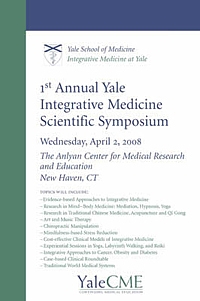 |
View or download the movie here > [18.5 Mb, flv file].
Dean of education Richard Belitsky and Dr David Katz
Pretty remarble uh? Dr Katz goes through several different trials, all of which come out negative. And what is his conclusion? You guessed.
His conclusion is not that the treatments don’t work but that we need a “more fluid concept of evidence” .
It’s equally bizarre to hear Richard Belitsky, Dean of Medical Education at Yale saying he is “very proud” of this betrayal of enlightenment values. If this is what Yale now considers to be education, it might be better to go somewhere else.
This is not science. It isn’t even common sense. It is a retreat to the dark ages of medicine when a physician felt free to guess the answer. In fact it’s worse. In the old days there was no evidence to assess. Now there is a fair amount of evidence, but Dr Katz feels free to ignore it and guess anyway. He refers to teaching about evidence as ‘indoctrination’, a pretty graphic illustration of his deeply anti-scientific approach to knowledge. And he makes a joke about having diverted a $1m grant from CDC, for much needed systematic reviews, into something that fits his aims better.
Katz asks, as one must, what should we do if there is no treatment that is known to help a patient. That is only too frequent a problem. The reasonable thing to say is “there is no treatment that is known to help”. But Dr Katz thinks it’s better to guess an answer. There is nothing wrong with placebo effects but there is everything wrong with trying to pretend that you are doing more than give placebos. Perhaps he should consider the dilemmas of alternative medicine.
You can read about more about Yale’s activities here and in interviews here. Dr Katz says “The founding approach—and I think Andrew Weil, MD, gets the lion’s share of credit for establishing the concept —is training conventional practitioners in complementary disciplines”. Let’s take a look at this hero. Try, for example, Arnold Relman’s “A trip to Stonesville“.
“According to Weil, many of his basic insights about the causes of disease and the nature of healing come from what he calls “stoned thinking,” that is, thoughts experienced while under the influence of psychedelic agents or during other states of “altered consciousness” induced by trances, ritual, magic, hypnosis, meditation, and the like.”
“To the best of my knowledge, Weil himself has published nothing in the peer-reviewed medical literature to document objectively his personal experiences with allegedly cured patients or to verify his claims for the effectiveness of any of the unorthodox remedies he uses.”
Here is the advertisment for Andrew Weil’s nutrition symposium.

Not only does this yet again propagate the great antioxidant myth, but a few moments with Google show that it is riddled with vested interests, as already pointed out on Quackademics in USA and Canada.
What has brought medical schools down to this level?
That isn’t hard to see, The main thing is simply money. Very few university administrators have the intellectual integrity to turn down money, whatever the level of dishonesty that is required by its acceptance. You can buy a lot of silence for $100m
The US Taxpayer has given almost a billion dollars, via NIH.

Wallace Sampson, MD says of NCCAM
“. . it has not proved effectiveness for any ‘alternative’ method. It has added evidence of ineffectiveness of some methods that we knew did not work before NCCAM was formed”
“Its major accomplishment has been to ensure the positions of medical school faculty who might become otherwise employed in more productive pursuits.”
“Special commercial interests and irrational, wishful thinking created NCCAM. It is the only entity in the NIH devoted to an ideological approach to health.”
NCCAM has given money from some very dubious trials too, Both Orac on Respectful Insolence and Dr RW (R.W. Donnell) have written recently about the NCCAM-funded trial of “chelation therapy”, as first exposed in a devastating article by Kimball C. Atwood IV, MD; Elizabeth Woeckner, AB, MA; Robert S. Baratz, MD, DDS, PhD; Wallace I. Sampson, MD on Medscape Today. This is a $30 million, 5-year, phase 3 Trial to Assess Chelation Therapy (TACT) for coronary artery disease.
“But how did such a crappy study ever come to be, much less be funded by the NIH to the tune of $30 million? The answer, not surprisingly, involves one of the foremost promoters of quackery in the federal government, Representative Dan Burton (R-IN).”
“We conclude that the TACT is unethical, dangerous, pointless, and wasteful. It should be abandoned.”
Orac comments
“TACT is not the only example of an unethical and scientifically worthless trial being funded not because the science is compelling but because powerful lobbies and legislators who are true believers in woo applied pressure to the NIH to do them”
The Bravewell Collaboration is the other major source of money. Forbes Business says “Bravewell is not some flaky New Age group”. Well dead wrong there, That is precisely what it is.
This group of ultra-rich people, according to its boss, Christy Mack, has a
So Bravewell is corrupting the search for real knowledge and real cures with big bucks. You can buy a lot of hokum for $100m. |
 |
The money comes from Morgan Stanley,
|
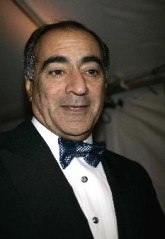 |
Bravewell is run by his wife, Christy Mack (Mack-the-wife?) Vice-President, The C.J. Mack Foundation, Member, Board of Directors, The Bravewell Collaborative.
The Flexner report.
The story of Bravewell stands in chilling contrast to another case of philanthropy. Andrew Carnegie’s foundation financed the report by Abraham Flexner, “Medical Education in the United States and Canada” (1910) [download, 15 Mb] . That report was responsible for dragging medical education out of the dark ages
almost a century ago. It resulted in creation of some of the best medical schools anywhere (including Yale).
“By educational patriotism I mean this: a university has a mission greater than the formation of a large student body or the attainment of institutional completeness, namely, the duty of loyalty to the standards of common honesty, of intellectual sincerity, of scientific accuracy.”
“The tendency to build a system out of a few partially apprehended facts, deductive inference filling in the rest, has not indeed been limited to medicine, but it has nowhere else had more calamitous consequences.”
Flexner (1910).
Now another philanthropist is using big bucks to reverse the process and push medicine back into the 19th century.
Flexner would have thought it quite inconceivable that in 2007 medical schools would be offering Continuing Medical Education in homeopathy.
Why are Yale’s academics so quiet about this?
Perhaps they don’t even know it’s happening. If they say firmly that they don’t want it, it will go,
It’s been done before
Florida State University, allegedly under political pressure, proposed to set up a school of Chiropractic. That would have made it Florida State school of snake-oil salesmanship. What a sad fate. [ Science magazine comment] [comment form Paul Lee] [Comment in St Petersburg Times]
But the academics stopped it. An FSU professor, Albert Stiegman, predicted the future campus map.
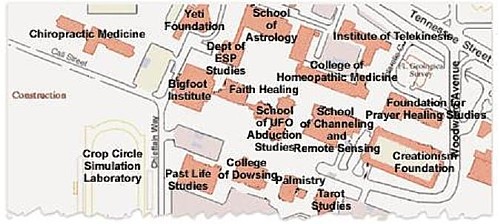
According to FSUnews
“The Florida Board of Governors voted 10-3 Thursday to deny Florida State University’s request to build a chiropractic school.”
“However, the passage of the bill for the chiropractic school by the Legislature seemingly bypassed the Board of Governors.”
In the end, reason won. Let’s hope that Yale follows their example.
Follow up
The problem of Yale has been taken up with great eloquence by some US commentators
Dr RW (R.W, Donnell): “Quackademic Medicine at Yale”
“By the way, where’s the AAMC in all this? Aren’t they supposed to be guardians of integrity and professionalism in medical education? Are they asleep at the switch or is money silencing them too?”
Orac (Respectful Insolence): “Integrative” medicine at Yale: A more “fluid” concept of evidence?”
“after the Dean of the Yale School Medicine embarrassed himself in the introduction by saying he’s proud of how far this nonsense has come, Dr. Katz takes the stage and demonstrates the sort of hostile attitude towards science that, if allowed to take root will be the death of scientific medicine in any meaningful form at U.S. medical schools”
Junkfood Science. Sandy Szwarc on “Quote of the day: ;We need a more fluid concept of evidence’”
“Will healthcare professionals and consumers . . . . speak out against these wellness programs being enacted by government agencies, insurers and employers? Or is the money too good?”
Science-based Medicine. Steven Novella writes on “Changing the rules of evidence“. When alternative medicine people do not like the evidence, they change the rules to get the outcome that they want, as seen so graphically in this post. They have always done this, but it is only recently that this sort of behaviour has been endorsed by places like Yale.
The Macho Response, another US blog, comments bluntly, in “Yale wants a more fluid concept of evidence”
This is beyond embarrassing – it’s a fucking crime – and it’s happening at Yale University and many others.
If you’re in the medical profession (and I know many of my readers are) you need to go here – now.
Kiosque Médias writes as follows
Pour ceux qui s’intéressent à la médecine et à la santé, le blog de David Colquhoun vaut probablement le détour. Ce professeur-chercheur au département de neurosciences, de physiologie et de pharmacologie de l’University College London y décrypte les résultats d’études médicales, en mettant l’accent sur les médecines alternatives. Et il est rarement tendre!
James Randi Newsletter. The hit rate soars after a recommendation this piece by the amazing Randi.
Hokum-Balderdash Assay. Edwardson writes
“Yale University is going to the ducks. It now has an Integrative Medicine program and in April held its first annual Integrative Medicine Scientific Symposium. I think there must’ve been a typo there. They must’ve meant “Ist Annual I.M. Pseudoscientific Symposium.” There! Now we’ve done away with the oxymoron.”
Why is Yale so secretive about its quackery department?,
Most universities are only to keen to boast about their grant income. Not in this case though. When I asked how they funded their quackery, all I got was a letter that had very obviously been drafted by a lawyer.
“As a private institution, Yale University is not generally subject to the U.S. Freedom of Information Act. We therefore respectfully decline to compile and provide the information you have requested.”
So pretty clear signs of guiltiness there.
Dr David Katz, yes, he of the “fluid concept of evidence”, has posted an article, Health Hazards of rhe Blogoshere. If it quacks like a duck . . .
It seems that he has been a bit alarmed by the reaction of the bloggers. It starts, rather pompously, thus.
“Being well educated does not guarantee you’ll always be right, and it certainly doesn’t guarantee everyone will agree with you. But it still matters. Or at least it used to “
But the rest if it reads less like a defence than as an admission of guilt, thus prompting the next item.
Paul Hutchinson’s blog
| A quack who admits it picks out a quotation from Dr Katz’s response and turned into a cartoon, released to the public domain, So here it is. |  |
Respectful Insolence.
Orac comments too, in “Fluid evidence” strikes back: Dr. Katz versus the skeptical blogsophere”. He does a terrific job in taking apart the response from the hapless Dr Katz.
“No, Dr. Katz does not like his first encounter with the medical blogosphere at all. Indeed, he is so unhappy that apparently a few weeks ago he tried t answer the bloggers who had raked him over the coals for blatantly advocating “integrating” unscientific woo like homeopathy with scientific medicine. Unfortunately for him, he did not do a particularly good job of it. Indeed, what most stood out as I read his rejoinder was that he does not answer a single substantive criticism leveled at his comments. Not one. Instead, he does what pretty much all woo-meisters do when criticized for shifting goalposts and appealing to other ways of knowing besides science as a means of “proving” that their preferred fairy dust works; he wraps himself in the mantle of the brave iconoclast willing to challenge accepted dogma and whines about the peons who criticized him, heaping contempt on the bloggers who had the temerity to criticize his advocacy for pseudoscience because to him they have not earned the right to criticize his (at least in his opinion, apparently) greatness in comparison to him.”
| Last year, Nature published a pretty forthright condemnation of the award of Bachelor of Science degrees in subjects that are not science: in fact positively anti-science. This topic has come up again in Times Higher Education (24 April 2008). A league table shows that the largest number of anti-science courses is run by the University of Westminster [download paper version]. |
 |
Vice chancellors have consistently refused to answer letters, from me, from the Times Higher Education or from the BBC, asking them to defend their practices.
The vice chancellors union, Universities UK, has simply refused to consider this very basic threat to academic standards.
It is particularly amazing that vice-chancellors continue to support courses in homeopathy when they have been condemned by no less a person than the head honcho of homeopathy in the UK, Dr Peter Fisher. He is clinical director of the Royal London Homeopathic Hospital and Homeopathic Physician to the Queen. Peter Fisher and I were interviewed on BBC London News after publication of the Nature article. At the end, Fisher was asked by the presenter, Riz Lateef, about whether homeopathy was a suitable subject for a science degree.[Watch the movie]
| Riz Lateef (presenter): “Dr Fisher, could you ever see it [homeopathy] as a science degree in the future? Dr Peter Fisher: “I would hope so. I wouldn’t deny that a lot of scientific research needs to be done, and I would hope that in the future it would have a scientific basis. I have to say that at the moment that basis isn’t comprehensive. To that extent I would agree with Professor Colquhoun.” |
The one exception was a response, of sorts, that I got from Westminster University.
I can interpret this lack of response only as a sign of guilt on the part of the vice chancellors of the 16 or so universities who teach this stuff. That interpretation is reinforced by the refusal of two of them to release their teaching materials, despite requests under the Freedom of Information Act 2000. Both the University of Central Lancashire and the University of Westminster have turned down appeals, and refused to hand over anything. The former case has been with the Information Commissioner for some time now, and if the ruling goes as a hope, the taxpayer may soon be able to see how their money is being spent.
But the wonderful thing about the electronic age is that it has become really quite difficult to keep secrets. Last year I managed to find an exam paper set by the University of Westminster in Homeopathic Materia Medica, and a question from that paper has already appeared in Nature.
I recently acquired copies of a course handbook. and of the powerpoint slides used for the lecture on ‘Vibrational Medicine’ by the University of Westminster. This appears to be from a course in Complementary Therapies, part of “Health Sciences: Complementary Therapies BSc Honours”, according to Westminster’s web site. A lot of people have access to this first year course material, so Westminster needn’t bother trying to guess how I got hold of this interesting material
In the public interest, here are a few quotations. Taxpayers should know how their money is being spent.
According to the handbook
“Complementary Therapies is a core module for the Therapeutic Bodywork, Herbal Medicine, Homœopathy, Nutritional Therapy and Complementary Therapies courses. Therefore all students of these degree courses are required to take this module.”
The University of Central Lancashire also has “Vitalistic Medicine” as part of its BSc Homeopathy (but, like Westminster, has some excellent people too).
There is a rather good Wikipedia entry on Vitalism, a topic that is now largely the preserve of cranks.

The handbook is wonderful. The word ‘evidence’. in the context of ‘does it work?’, does not occur a single time. There is plenty of the usual edu-bollocks jargon that is so beloved by bureaucrats, but not the slightest hint of critical thinking about assessment of the ‘therapies’.
The course seems to be a romp through almost every form of battiness known to humankind. Not just homeopathy, traditional Chinese medicine and nutritional therapy, but also dowsing, crystal healing and other forms of advanced delusional thinking. Before somebody grumbles, let me emphasise that ‘nutrition’ is to be distinguished from ‘nutritional therapy’: the latter involves imaginative claims that buying expensive supplements can prevent or cure almost anything. There’s a lot more about that here, and here.
Here are just 5 days from the timetable.
| 9am-1.00pm : Homœopathy (group work and video) |
| 9am-1.00pm : Traditional Chinese Medicine |
| 9am-10.45pm : BODYWORK THERAPIES |
| 11.15-1.00pm : Nutritional Therapy |
| 9am-1.00pm : Vibrational Medicine/Energy Concepts (L&P) |
All this can be yours -at a cost.
Full-time UK/EU fee – £3,145
Full-time Overseas fee – £9,450
The slides for the last of these lectures show some of the most glorious examples of the abuse of sciencey-sounding words that I’ve seen in a while.
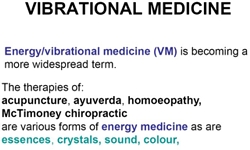 |
 |
Sigh. All this is sheer imagination. It is ancient vitalism dressed up pretentiously in sciencey words.Then a bit later we come to the general theory -“energy concepts”.
 |
 |
More plausible-sounding, but utterly meaningless words about vibrations. And then on to old superstitions about dowsing with rods and pendulums.
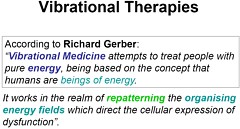 |
 |
.
Not a single word of scepticism appears about any of this mumbo jumbo. Can it get worse? Yes it can. CRYSTAL HEALING comes next.
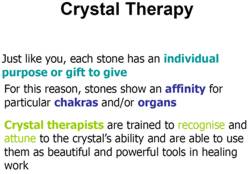 |
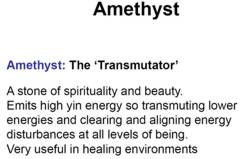 |
Are you having difficulty in understanding what all these words mean? I certainly hope so, because they have no meaning to understand. Don’t worry too much though, There are some helpful diagrams.
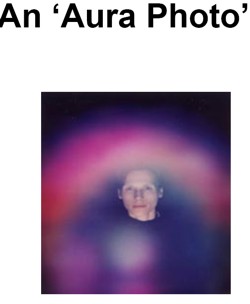 |
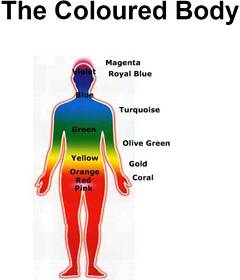 |
Aura photographs? They are just fairground conjuring tricks. Well, that is what you thought. But here we see them presented, apparently in all seriousness, as part of a vocational bachelor of science degree in a UK
university.Never mind, it is all assessed properly, with all the right box-ticking jargon. The course handbook says
| Learning Outcomes On successful completion of this module you will be able to: • describe the theoretical basis and classification of a range of complementary therapies |
What theoretical basis? There isn’t any theoretical basis, just a meaningless jumble of words.
You just couldn’t make it up.
Westminster University is not all like this
This post is not intended as an attack on the University of Westminster as a whole. Last year I had an invitation from their biomedical people to give a talk there. They asked for a talk on “What is is the evidence for Alternative Medicine?”. But then I got an email from them saying
“I was surprised to be sat on heavily on return from said trip by the VC, Provosts and Deans (including Peter Davies the leader of the Alt Med School !) once news of your talk leaked out. Could you give a talk on your research instead- yep I know its pusillanimous of me and yep I know unis stand for freedom of speech and yep I know that fellow members of staff suggested you come and others were keen to listen to your views on quackery.”
So on November 2nd 2007 I gave a seminar about single ion channel work (our new ideas about partial agonists). Of course all the excellent staff whom I met agreed with me about the embarrassment that having degrees in homeopathy etc. The fault lies not with their academic staff, but with their administration. Freedom of speech does not seem to be high on their agenda.
Postscript I recently learned that when Times Higher Education asked Westminster about my seminar, they were given the following statement.
“Prof David Colquhoun was invited to take part in a research seminar series organised by the University’s School of Biosciences last year. As part of this series, on Friday 2 November 2007, he gave a talk on the agreed topic of “Single ion Channel studies suggest a new mechanism for partial agonism” – his area of research.”
Perhaps I am naive, but it truly shocks me that a university can issue such a dishonest account of what happened.
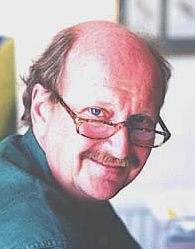 |
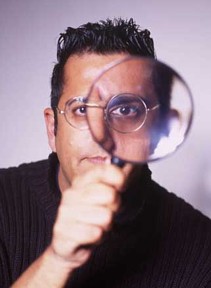 |
The Times published a letter from Edzard Ernst and Simon Singh on April 16th. In their forthcoming book, Trick or Treatment? Alternative Medicine on Trial, they go carefully through all the evidence for all sorts of ‘alternative’ treatments. They find some evidence that a handful of them work. For most the answer is ‘not enough evidence’, and for a number there is good evidence that many of them don’t work to any useful extent.
“Sir, For over two decades the Prince of Wales has been actively promoting alternative medicine and his Foundation for Integrated Health continues to encourage the use of treatments such as homoeopathy or reflexology.””In light of this “rigorous scientific evidence”, we strongly advise that the Prince of Wales and the Foundation for Integrated Health withdraw the publications Complementary Health Care: A Guide for Patients and the Smallwood report. They both contain numerous misleading and inaccurate claims concerning the supposed benefits of alternative medicine. The nation cannot be served by promoting ineffective and sometimes dangerous alternative treatments.”
Thank heavens that someone has the courage to say it as it is.
If only the ineffectual and ill-educated people in the Department of Health wouold do the same. But no, instead they gave £37 000 to the Prince of Wales Foundation to write their make-believe guides. And £900 000 to write nonsense for the Complementary and Natural Healthcare Council (also known as Ofquack), and Skills for Health,
The next day The Times ran an article by their science editor, Mark Henderson, Prince of Wales’s guide to alternative medicine ‘inaccurate’. Natasha Finlayson, of the Prince’s Foundation for Integrated Health, is quoted as saying “The foundation does not promote complementary therapies.”. That takes some beating for sheer bare-faced dishonesty.
Edzard Ernst appeared on the Today Program on 18th April. He was interveiwed by the formidable John Humphrys, along with Kim Lavely, Chief Executive, The Prince’s Foundation for Integrated Health (FIH). Ernst points out that the FIH guide suggests that chiropractic is effective in asthma, and that acupuncture is good for addiction, whereas the evidence says the opposite. Lavely retorts, rather lamely (OK I’m biassed).
Lavely: ” . . . we didn’t attempt to give detailed evidence on every therapy”. “We think they [the public] have the right to know and what doesn’t”
Humphrys: “Well isn’t that the whole point? the professor is saying here is that these things do not work, at least in terms of the claims that are made for them, such as homeopathy and chiropractic . . . ”
Lavely: “There are no claims made in this guide for what works and what doesn’t. What we have said is that some therapies are used for some things but we aren’t saying they are effective for those things . . . “
So, one might ask, what on earth is the use of a guide is it that offers no indication of effectiveness? Lavely’s second quotation contradicts directly her first. A pretty pathetic performance.
Listen to the interview [mp3 file]
The Sunday Times, on April 20th, pblished a pretty good review of Trick of Treatment?. “Their case against the folly, vanity and damage of HRH et al. is hard to argue with.”
Of course, the letters column drew the expected response from the quacks, most verging on the hilarious.
Another blow for the alternative industry came in the same week, The authoratitve Cochrane review confirmed earlier reports that vitamin supplements not only do not help you but some actually increase mortality. The antioxidant myth nevertheless rumbles on, and on, and on. There is too much money in it for it to die easily.
Predictably enough, the conclusions were denied by the Health Food Manufacturers’ Association (HFMA). They wheeled out several pop singers to say how wonderful their products are. Read about that pathetic defence on Holfordwatch.
Who is behind HFMA? Incidentally, HFMA are strangely reticent about the identity of their 120 members. They will not reveal who they are. Does anybody out there know the answer? I’ll buy a good dinner for anyone who can root this out. If it is anything like the ‘Health Supplements Information Service‘ it is likely to be backedby the very big pharmaceutical companies that the alternative industry loves to hate.
Take the test
Prince of Wales Guide
“Reflexologists work with a wide range of conditions including certain types of pain, particularly back and neck pain, migraine and headaches, chronic fatigue, sinusitis, arthritis, insomnia, digestive problems such as irritable bowel syndrome, and constipation, stress-related disorders and menopausal symptoms.”
Singh & Ernst
“The notion that reflexology can be used to diagnose health problems has been disproved and there is no convincing evidence that it is effective for any condition.”
Boots the Chemists have proved themselves dishonest before, over their promotion of homeopathy and of B Vitamins “for vitality”
In a press release dated 12 March 2008, they have hit a new low in ethical standards
| Boots help boost the nation’s energy levels in just one week “Health and beauty expert Boots has launched an exclusive energising vitamin supplement that helps boost depleted energy levels and maintain vitality. It is the first time that this exclusive form of CoQ10 has been made available on the high street.” ” . . .supplementation can help to supply higher levels of CoQ10 than are available in the diet. Boots Energy Super Strength CoQ10 containing natural Kaneka CoQ10 is a way of boosting energy levels that can help people who lack energy to see results in a week” |
You decide.
Last year there was an equally misleading press release about CoQ10 from Solgar/Boots Herbal. That one was headed “Need More Energy – Solgar’s Nutri Nano™ Uses Nanotechnology to Deliver Unprecedented Bioavailability of CoQ10”. Not only is the word ‘energy’ misused but notice that the trendy term ‘nanotechnology’ is worked in for extra sciencey effect. It turns out that all this means is that the preparation contains micelles. So nothing new there either. Micelles have been known for almost 100 years.
In contrast, the Boots online store is noticeably more restrained. Could that be because the Advertising Standards People can’t touch press releases, just as they can’t control what Boots Expert Team tell you face to face in the shop?
Boots PR contact is given as: Carrie Eames, PR Manager, Boots The Chemists, D90W WG14, Thane Road, Nottingham NG90 1BS. I’m not sure how Ms Eames sleeps at night. Perhaps you should write to her and let her know what you think.
You might point out to her Boots (anti) Social Corporate (ir)Responsibility Page. It says
| “So it’s part of our heritage to treat our customers fairly and act with integrity in everything we do, rather than seizing on the quickest and easiest way to turn a profit.” |
CoQ10 and “energy”
Coenzyme Q10 (also known as ubiquinone) is a relatively small molecule. It cooperates with cytochrome enzymes (big proteins) to synthesize a molecule called ATP. This is a chemical form of energy that can be used to do work, such as making a muscle fibre contract.
The word “energy ” here is used in the sense that a physicist would use it. It is measured in joules or in calories. The meaning of the word ‘energy‘ is described nicely in the Wikipedia entry. For example, when an electric current passes through a resistor (like a kettle) the electrical energy is converted to heat energy, and the energy used is potential difference (volts) X current (amps) X time. In other words energy is power (in watts) times time. So another unit for energy is kilowatt-hours (one kilowatt-hour is about 3.6 megajoules).
Energy in this sense has nothing whatsoever to do with the everyday use of ‘energy’ to indicate your vitality, or how lively you feel.
Furthermore there is not the slightest empirical reason to think that CoQ10 makes you feel more lively. None. The press release cites a sciencey-sounding reference (Ernster L, Dallner G. Biochemical, physiological and medical aspects of ubiquinone function. Biochim Biophys Acta. 1995 May 24;1271(1):195-204.). But this paper is just a review of the biochemistry, nothing whatsoever to do with feeling good.
CoQ10 and the supplement business
There is nothing new in this big push by Boots. CoQ10 has been a staple of supplement business for a long time now. All sorts of medical claims have been made for it. Everything from migraine, to Parkinson’s disease to cancer has been raised as possible benefits of the magic drug, oops, I mean ‘supplement’. This is quite improper of course, since it is being sold as a food not as a medicine, but it is standard practice among supplement hucksters, and so far they have been allowed to get away with it.
What’s interesting though is that until Boots PR machine swung into action, one thing that hadn’t been claimed much is that it made you feel more lively. That’s one they just invented.
CoQ10 and the press
It’s standard technique to get free advertising by hoping that journalists will dash off an article on the basis of a press release, with the hope that they will be in too much hurry to check the spin. Too often it works.
The Daily Mail has big coverage of the press release, under the title “Can a 60p pill from the chemist really add years to your life?“. This was written by Anna Hodgekiss and it’s not bad. It starts with a nice note of scepticism
“Forget vitamins C, E or even B12. The real wonder supplement is Coenzyme Q10 or CoQ10. That’s what Boots would have you believe, anyway. ”
“So should we all be taking this supplement?Not according to David Colquhoun, professor of pharmacology at University College London, who says Boots’ claims are “deliberately misleading customers”.
“Yes, CoQ10 helps the body convert glucose into energy, but it’s not the psychological get-up-and-go energy you feel day to day.
“The type of energy it does produce powers our muscles and cells – physical energy. They have confused the two here to promote a product that I’m not convinced would make any difference to how you actually feel at all.”
The article goes on
Among the other sceptics is Scott Marsden, a senior dietician at The London Clinic.
“There haven’t been enough trials to warrant us all taking CoQ10,” he says.
“It sounds boring, but if you are healthy and eating a balanced diet, you will get all the nutrients you need and shouldn’t have to take supplements.
“Not only could you be spending money unnecessarily, you could also be putting your health at risk. Buy some wholesome food instead.” “
Dr Clare Gerada, vice chairman of the Royal College of General Practitioners, is more forthright.
“While there is some evidence to suggest CoQ10 supplements may help patients with heart failure or severe respiratory disorders, more work is needed,” she says.
“This is just another example of normal health being medicalised, and it’s an issue that worries me.
“The human body is an amazing machine, and we have never been in better health. The fact that more people are living well into their 80s and 90s is proof.
“People need to stop looking for a wonder pill in their quest to live for ever.”
But guess who comes out fighting for Boots? None other than my old friend Dr Ann Walker. Little wonder then that my Nutriprofile result recommended a co Q10 supplement, because she is involved in that too.
Ann Walker’s colleague on the Nutriprofile project, Dr Sarah Brewer comments on CoQ10 on the Healthspan site, thus.
“As CoQ10 is vital for energy production in muscle cells, lack of CoQ10 is linked with lack of energy, physical fatigues, muscle aches and pains . . .”
It seems that she also can’t distinguish between energy in joules and energy as vitality,
Female First and Marie Claire also carry a story “Boots Sell ‘Life Extending’ Pill”
“A new pill that claims to add years to our lives is due to hit shelves in Boots stores this week but scientists say the drug is misleading.”
“Despite these claims Professor David Colquhoun told Marie Clare that he believes the drug is ‘deliberately misleading customers’: “Yes, CoQ10 helps the body convert glucose into energy, but it’s not the psychological get-up-and-go energy you feel day to day,” he said.”
(Funny, I never consciously spoke to Marie Claire but the quotation is OK.)
The Times, in contrast, carries an appalling column by their Dr Thomas Stuttaford, “A natural solution to tiredness“. There isn’t even a question mark in the title, and the content is totally uncritical. Private Eye has nicknamed the author ‘Dr Thomas Utterfraud’. How very cruel.
See also, excellent articles on CoQ10 by Ben Goldacre in the Guardian, and at badscience.net, and at Holfordwatch and Dr Aust’s Spleen
Aha Boots have repeated their mendacious claims in newspaper advertisements
This appeared in the Guardian on 18 March, and I’m told it was in the Mail too.

The small print says
“The new Boots Energy supplement contains Kaneka Q10 to help boost your energy levels throughout the day”
Here is what I just sent to the Advertising Standard Authority, or email new.complaints@asa.org.uk . Why not have a go yourself?
| “The words “boost your energy levels” and “still lacking energy” constitute a (presumably deliberate) confusion beteen ‘energy’ measured in joules and the everyday use of the word ‘energy’ to mean vitality. The former usage would be justified in viewof the role of Coenzyme Q10 in ATP production. There is neither theoretical justification nor any empirical evidence that CoQ10 helps your vitality or ‘energy’ in the latter sense.” |
A full size graphic to attach to your complaint can be downloaded here.
We are all interested in the relationship between our health and what we eat. What a pity that so little is known about it.

The problem, of course, is that it almost impossible to do randomised experiments, and quite impossible in most cases to make the experiments blind. Without randomisation there is no way to be sure about causality, and causality is all that matters. All you can do is measure “associations” and that sort of information is simply unreliable.
For example, if you simply observe that people who eat a lot of dark green vegetables are healthier than those who don’t, there is no reliable way to tell whether their health is caused by eating the vegetables. It is just as likely that, for example, rich people are healthier because the are rich, not because they eat more vegetables. The answer, though usually not known, is the only thing that matters for offering advice. The crucial problem is that, in the latter case, it will do no good at all to bully a poor person to eat more vegetables: their health will not improve because their bad health was caused by poverty, not by lack of vegetables.
It is precisely this difficulty that results in the constantly conflicting advice that we are given about diet. I can’t think of any single thing that does more harm to real science than the fact that one week we are told that red wine is bad and the next week we are told that red wine is good. No doubt both statements were based on a naive observational studies, the significance of which is vastly exaggerated by its authors (and often by their university’s media department too).
The first job of a scientist is to be able to say “I don’t know”. Under pressure from the government’s audit culture, and the HR apparatchiks who embrace it so eagerly, all that is forgotten only too easily. he lack of certain answers about diet leaves a vacuum into which not only naive scientists are sucked, but also it is a gift for hucksters who are eager to sell you expensive ‘supplements’, whether or not you need them. As always, it is a case of caveat emptor.
The questions are important to us all, so when sciencepunk pointed out to me a chance to check my own diet, I went for it. I try to keep pretty close to the current guidelines. Unreliable though they may be, they are the best we’ve got. So I went to the Nutriprofile site, and filled in the questionnaire, quite honestly (apart from saying I was 37 -I wish).
I eat plenty of fruit and oily fish every week so I though I’d do quite well. No such luck. I ended up being told I was deficient in iron and selenium, and at “risk of deficiency” in vitamin B5 (pantothenic acid), folate, vitamins D, E, K, magnesium, copper and potassium.
Uhuh, I must really be ill and I’d never realised it.
At the bottom of this analysis of all my deficiencies comes the sales pitch, “your personalised supplement recommendations”.”Strongly recommended” for me is Gold Standard A-Z Multivitamins (just click on the “buy now” button). I’m also “recommended” to buy Omega 3 1000mg capsules.
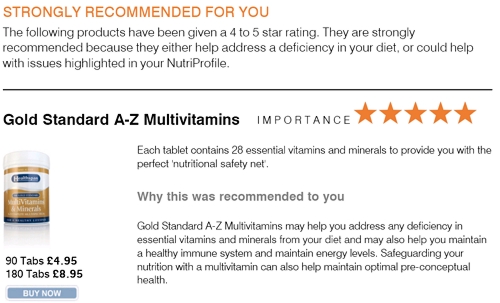
And then I’m invited to consider a whole list of other supplements
“The following products have been given a 1 star rating. This usually means they have been recommended to meet a specific issue raised by your NutriProfile. You should consider these supplements where you feel they could help if the issue is particularly important to you”
Here is the list.
- Selenium + A,C,E,
- Echinacea (“may help you maintain a healthy immune system”).
- OptiFive (antioxidant supplement)
- Co-enzyme Q10 (“may help you maintain energy levels” -look out for a forthcoming post on this scam)
- Memo Plus (“may help you maintain brain health and cognitive function”),
- Panax Ginseng (“may help you to maintain energy levels”
- Psyllium Husks
- Magnesium
- Vitamin D
- Ginkgo Biloba
- Probiotic
As always, there are lots of fantasies about “strengthening the immune system”. And the great antioxidant myth is exploited to the full.
Puzzled by this result, I got my wife to do the questionnaire, and also a particularly healthy and diet conscious colleague.
My wife was recommended to buy Omega 3 1000mg, Osteo Plus Bone health supplement (despite telling them that she already took calcium) and 50 Plus Multivitamins (“may help you address any deficiency in essential vitamins and minerals and may also help you maintain a healthy immune system and maintain energy levels. “). And then it may not.
My spectacularly healthy and diet conscious colleague got a strongly recommended (maximum 5 stars like me) for Gold Standard A-Z Multivitamins and for Omega 3 1000mg, as well as “recommended” for plant sterols, garlic and Opti-Omega 3.
Either I’m a lot unhealthier than I thought, or Nutriprofile is a sales scam.
You decide.
Is there anyone at all who does NOT need supplements?
By this stage I was getting suspicious so I sent the link to a professional dietitian, Catherine Collins of St George’s Hospital London. Unlike the people running the site, she has no financial interest in selling you pills. I asked her to fill in the questionnaire as a hypothetical person who had an ideal diet, based on current nutritional knowledge . Surely such a paragon of dietetic virtue would not need to buy pills too?
Don’t you believe it. At least she didn’t get any 5 star “strongly recommended”, but she did get “Recommended for you” Opti-Omega 3 (3.5 stars) and Gold Standard A-Z Multivitamins (3 stars). Plus, of course the whole list of “you may like to consider”, same as everyone seems to get.
So I asked Collins how it came about that everyone seems to end up being recommended to buy pills after going through all the questions. Here is what she said.
“Apparently my ratio of omega3:6 is unbalanced. not if you ate the amount of oily fish i’d put in, and used ‘vegetable’ oil which is mono-rich rapeseed. I think they’ve used the sunflower analysis to generate this distortion.
I disagree with absolute amounts of omega-3 per day. The amount I recorded meant I would easily exceed a daily intake of 500 mg of the important omega-3 fats, EPA and DHA
Low Vitamin B6 and folate – totally incorrect recommendation based on my entries
Potassium – the survey indicated concern that diet provided 200mg per day less potassium than recommended. This was incorrect, the flaw I assume being due to inability of the questionnaire to handle portion sizes. Should I have been worried even if this had been accurate? Of course not. Potassium is widespread across food groups, the most concentrated being fruit and vegetables. It is an essential nutrient, but its requirements are relative to sodium (‘salt’) intake.
Their omega-3 fat recommendation is double the FSA/ SACN suggestion of 450mg/d – they actually quote this in their supporting information but then say ‘experts say we need double’ [their experts are below]. This is highly misleading. We need a combination of omega-3 fats in our diet for health – not only the ‘fishy’ EPA and DHA, but also the readily available ALA, found in vegetable (rapeseed) oil
Omega 3:6 ratio -completely wrong based on the foods entered. Demonstrates a major flaws in the assumptions made about type and amount of foods in the diet.
Water recommendations. Totally inaccurate information based on the myth expounded by the health food industry and its workers that caffeine is a diuretic. This been extensively researched and proven to be not true ( Grandjeans excellent work). The only way in which a caffeinated beverage is ‘diuretic’ to someone who takes caffeinated drinks regularly is in the volume of drink consumed.
She concludes
“”This appears an elaborate pill-pushing exercise. Superficially reassuring in promoting the recognised FSA (Food Standards Agency] line – but then giving undue – and unjustifiable – support to the anecdotal ‘experts recommend’ to create what will be a powerful sell”
The comment about water intake stems from this bit of Collins’ Nutriprofile:
“Caffeinated drinks, fizzy drinks and alcohol do not count because, whilst they contain water, they are mild diuretics, ie. they boost urine output and therefore should only form a small part of your total fluid intake.”
This myth (aka nutribollocks) is quite contrary to what the real research (going back to 1928) says, Check “Laying the caffeine myth to rest” for the real story..
I’m told that Healthspan are now sending out the paper questionnaire in newspapers. Presumably this is to ensure that the poor, the elderly etc and others who that aren’t computer literate don’t miss their buying opportunity. How considerate of them.
Nutriprofile’s expert team
Who is the expert team behind Nutriprofile? Here they are.
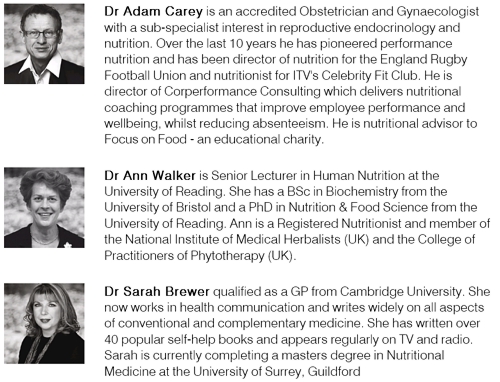
 |
 |
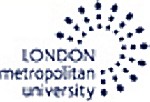 |
What do the real experts say about supplements?
The story you get is quite different when you ask somebody who is not trying to sell you something
The Food Standards Agency says
“Most people should be able to get all the nutrients they need by eating a varied and balanced diet. But if you choose to take supplements, it’s important to know that taking too much or taking them for too long can cause harmful effects.”
Harvard Men’s Health Watch says
“Harvard Men’s Health Watch suggests that the average man give up the multivitamin, at least until scientists solve the puzzle of folic acid and cancer.”
“If you eat a balanced diet that includes food from all the major groups, there should be no need to take vitamin supplements. The food you eat will provide you with all the vitamins and minerals you need. “
I guess we should not be surprised at the direct contradiction between this advice and that of the Nutriprofile questionnaire. After all, Nutriprofile was developed by a company, Healthspan, that is devoted to selling “supplements” with all the dubious claims and customer testimonials associated with the alternative health industry.
But this is what always happens when big business controls science.
Postscript
Oddly enough, Ann Walker’s experience seems to be much the same as ours. In an interview on the Healthspan site we read this.
Q: Which nutritional supplements do you choose to take?
A: I regularly take a multivitamin, vitamins C and E, fish oil, and a calcium and magnesium combination. I also take vitamin D during the winter and some herbs as and when they are needed.
Even if I have improved my diet, each time I complete the NutriProfile questionnaire my requirement for a multivitamin, calcium and magnesium, and a fish oil supplement are always thrown up.
Didn’t it occur to her to wonder why?
The sales pitch was followed up on 27 March the email arrived from Healthspan “Healthspan are offering you £5 to spend towards your recommended supplements”. One can’t say whether this offer goes to people who were not recommended supplements, because so far no such person has been found.
This is the third post based on a recent trip to North America (here are the first and second)
One aspect of the endarkenment, the Wal-Mart model of a university, is very much the same in the US as in the UK. At one US university, an excellent scientist offered the theory that an alien spacecraft had scattered spores across the land which developed into HR staff who appeared at first sight to be human, and who colonised academia.
The penetration of quackademics into US universities is a bit different from in the UK.
In the UK, the plague is restricted to sixteen or so ex-polytechnic universities which, to their great shame, actually offer Bachelor of Science degress in subjects like homeopathy. There are bits of quackery in good teaching hospitals (such as laying-on-of-hands at UCLH), but not very much.
In the USA and Canada, this sort of “vocational” training does not occur much in universities, but in separate colleges. The situation is worse there though, insofar as these colleges have been allowed to award titles like ‘doctor of naturopathic medicine (ND)’, for work that in no respect compares with what the rest of the world has to do to earn a doctorate. This prostitution of academic titles has not happened to anything like the same extent in the UK. How our own quacks would love it if they were allowed to call themselves ‘doctor’ and sport the initials ND (so easily mistaken for MD at first sight).
It is on the clinical side where the situation is far worse than in the UK. Almost every university hospital, including Harvard, Yale and Stanford, has departments devoted to fairy-tale medicine.
Quacks use a number of euphemisms to make themselves sound more respectable. First they became ‘alternative medicine’, then ‘complementary medicine’. Now the most-used euphemism is ‘integrative medicine’, which is favoured by most US universities (as well as by the Prince of Wales). Raymond Tallis pointed out that this seems to mean integration of treatments that don’t work with treatments that do work.
An official roll of shame for North American universities can be seen here (35 in USA and 4 in Canada). 
A bigger collection of 44 universities has been posted by the incomparable Orac at the The Academic Woo Aggregator. He’s had good support in the USA from DrRW (R.W. Donnell), see particularly his articles on How did pseudoscience get admitted to medical school? and What is happening to our medical schools? Abraham Flexner is turning over in his grave.
All these outfits have two things in common. They all claim to be scientific and evidence-based, and none has produced any real evidence that any of their treatments work.
Here are a few examples of what’s going on.
Yale University School of Medicine

The usual theme is expressed thus.
“Through open-minded exploration and rigorous scientific inquiry, we aim to improve awareness and access to the best in evidence-based, comprehensive medical care available worldwide, with the goal of optimizing health and healing for patients”
The driving force behind the woo seems to be a fourth year medical student, Rachel Friedman, so I wrote to her to ask what useful alternative treatments had been established by research at Yale. But she could not identify any. All I got was this.
“My best advice would be to do some medline searching of metaanalyses” there’s been enough research into some of these modalities to provide for a metaanalysis.”
So she was unable to produce nothing (and anyway. metanalyses, useful though they may be, are not research).. A glance at the Yale publications page shows why.
The Scripps Institute
![]()
Scripps Center for Integrative Medicine says
“In use at Scripps since 1993, Healing Touch is an energy-based, non-invasive treatment that restores and balances energy to help decrease pain and relieve associated anxiety.
Healing Touch is performed by registered nurses who recognize, manipulate and balance the electromagnetic fields surrounding the human body, thereby promoting healing and the well-being of body, mind and spirit.”
“Balances energy”?
“manipulate and balance the electromagnetic fields surrounding the human body”?
This is just meaningless baloney. And it come from the Scripps Institute.
The Oregon Health & Science University
![]()
![]()
OHSU is an excellent and well-respected research university where I have many friends. It was a pleasure to meet them recently.
But it also has a big department of “Complementary and alternative medicine” and an “Integrated medicine service”. There are some good bits of advice mixed up with a whole range of crazy stuff. Take their page on homeopathy.
“This therapy treats ailments with very small amounts of the same substance that causes the patient’s symptoms.”
WRONG. In most cases it is zero amount. To brush this fact under the carpet is simply dishonest (and perhaps a sign of guilt). Then comes this (my emphasis)..
Explanations for why homeopathy works range from the idea that homeopathic medicine stimulates the body’s own natural defenses to the idea that homeopathic medicine retains a “memory” of the original substance.
However, there is no factual explanation for why homeopathy works and more research is needed.”
WRONG. This statement carries (twice) the expicit message that homeopathy does work, quite contrary to a mountain of good evidence that it is merely a placebo. The statement is deceptive and dishonest. And it comes with the OHSU logo.
The University of Arizona

” Heal medicine”, “Transform the world?” Modest uh?
The University of Arizona Program in Integrative Medicine is certainly not modest in its claims, but its publications page shows that it doesn’t even attempt to find out if its “therapies” actually work.
Here is an example. They are advertising their Nutrition and Health conference
heavily.

There’s nothing wrong with good nutrition of course, but the ‘alternative’ approach is instantly revealed by the heavy reliance on the great antioxidant myth.
And look at the sponsors. The logo at the top is for Pistachio Health, a company that promotes pistachio nuts: “Delicious and good-for-you, pistachios are nature’s super heart-healthy snack. Nutrient dense, full of fiber and antioxidants, pistachios give you more bang per calories than any other nut.”.
The other advertisement is ‘POM Wonderful’, a company that sells and promotes pomegranate juice, “POM is the only pomegranate juice you can trust for real pomegranate health benefits”
No doubt pistachio nuts and pomegranate juice are perfectly good foods. But the health claims made for them are just marketing and have very little basis in fact.
Now let’s look at the speakers. Take, for example, Dr David Heber, MD., PhD. He is director of the UCLA Center for Human Nutrition at the University of California, Los Angeles, a professor of Medicine and Public Health, and the founding Chief of the Division of Clinical Nutrition in the Department of Medicine. He is the author of several books including “What Color is Your Diet” and the “L.A. Shape Diet.” With the possible exception of the books, you can’t sound like a more respectable and impartial source of advice than that.
But hang on. Dr Heber is to be seen in a video on the Pistachio Health web site doing what amounts to a commercial for pistachio nuts.
OK let’s take a look at one of Dr Heber’s papers. Here’s one about, guess what, pomegranate juice. “Pomegranate Juice Ellagitannin Metabolites Are Present in Human Plasma and Some Persist in Urine for Up to 48 Hours”. The work was “Supported by the Stewart and Lynda Resnick Revocable Trust and from the NIH/NCI grant P50AT00151”. So no problems there. Well not until you check POM Wonderful in Wikipedia, where you find out that Stewart and Lynda Resnick just happen to be founders of POM.
Of course none of these interesting facts proves that there is anything wrong with the work. But they certainly do show that the alternative nutrition business is at least as much hand-in-glove with big business as any other form of medicine. And we know the problems that that has caused.
So, if you want impartial advice on nutrition, sign up for the 6th Annual Nutrition and Health meeting. For “MD, DO, ND & other doctors”, it will cost you only $845 to register .
The meeting is being run by The University of Arizona College of Medicine and Columbia University’s College of Physicians and Surgeons.

![]()
The University of Arizona is, incidentally, also the home of the famous (or perhaps infamous) Gary Schwartz (see also, here). He “photographs” non-existent “energy fields” and claims to be able to communicate with the dead, and he is director of its Human Energy Systems Laboratory at the University of Arizona. He is also head of the inappropriately-named Veritas Research Program and “Centre for Frontier Medicine in Biofield Science”. All of these activities make homeopathy look sane, but he is nevertheless part of an otherwise respectable university. In fact he is He is Gary E. Schwartz, Ph.D. is professor of psychology, medicine, neurology, psychiatry and surgery at the University of Arizona. Even more incredibly, this gets NIH funding.
Columbia University, along with Cornell, also has its own “Complementary, alternative, and integrative medicine“, defined as “the use of treatments, such as homeopathic medicine, ayurveda, botanical dietary supplements”. And their “Integrative Therapies Program for Children” is intimately tied up with a company called Origins, which is more a cosmetics company, Origins” (with all the mendacity that implies). They say
“Origins understands the importance of addressing wellness through an integrative approach,” says Daria Myers, President of Origins Natural Resources. “With our recent Dr. Andrew Weil collaboration, Origins demonstrated its support for the integrative wellness concept. Now, with the introduction of the new Nourishing oil for body and massage, we hope to bring not only a moment of comfort but also a healthy future to children enduring the fight of their life.”
Andrew Weil is, of course, the promoter of the Arizona meeting.
The corruption of Universities by this sort of activity is truly amazing.
| “the report is more hypothesis-generating for future research than a rigorous scientific study. Find us some money and we will do a proper job. You can quote me for that.” Professor David Smith (Oxford). Scientific adviser for Food for the Brain. |
For a quick synopsis, look at Holfordmyths.org.
Patrick Holford and Drew Fobbester are joint researchers and authors of the Food for the Brain Child Survey , September 2007 (pdf). Holfordwatch has made a very thorough study of this report, in eight parts (so far). They conclude
“HolfordWatch can not share the optimism for these claimed benefits and finds that there is insufficient data to support them in a robust manner.”
There are many detailed questions, but the basic problem with the report is very simple. The fact that is (a) self-selected and (b) not randomised make it just another naive observational study. The stunningly obvious confounder in this case is, as so often, the socio-economic background of the kids. That was not even assessed, never mind any attempt being made to allow for it.
This isn’t just pedantry because what matters is causality. It is worth very little to know that eating vegetables is correlated with high SAT score if the correlation is a result of having well-off parents. If that were the reason, then forcing kids with poor parents to eat vegetables would make no difference to their SAT score because their parents would still be poor. The only conclusion of the study seems to be that we should eat more fruit and vegetables, something that we are already lectured about in every waking moment.
Many questions about the report have not yet been answered by its authors. But the report has a panel of scientific advisors, some of whom at least seem to be very respectable (though not ‘orthomolecular medicine‘, which is a cult founded on the batty late-life beliefs of the once great Linus Pauling that Vitamin C is a magic bullet).

Furthermore they are thanked thus
![]()
As it happens, David Smith is an old friend, so I wrote to him, and also to Philip Cowen, with some detailed questions. I didn’t get detailed answers, but the responses were none the less interesting. Cowen said
“I did see the report and quite agree with your conclusions that it an observational study and therefore not informative about causality.”
“The advice about diet seems reasonable although, as you point out, probably somewhat redundant.”
But still more interesting, David Smith told me (my emphasis)
“the survey was the largest of its kind and was done on minimal funding; hence several matters could not be dealt with and so the report is more hypothesis-generating for future research than a rigorous scientific study. Find us some money and we will do a proper job. You can quote me for that, if you wish.”
I’d grateful to David for his permission to quote this comment, It seems that Holford’s top scientific advisor agrees that it is not a rigorous study, and even agrees that the “proper job” is still to be done.
But it does seem a shame that that was not made clear in the report itself.
One of the effects of this affair has been the posting of some critical examinations of some of the writings of Dr Ann Walker. I make no comment. The links are here.
This item appeared originally on the old IMPROBABLE SCIENCE page
The reversal of UCL’s request to remove this page from UCL’s server was, in large part, the result of the power of the blogosphere. Here are some of the things that did the trick.
“Moved to tears by the beauty of blogs”. Goldacre wraps up the affair in the Guardian, and on badscience.net (“Stifling Debate – When Bloggers Attack”).
He gives links to the close examination of the work of Dr Ann Walker that that is now appearing.
“UCL have just issued a smashing statement on Prof Colquhoun’s de-excommunication.” Comment from badscience.
This episode seems to have sparked a close inspection of some of the claims made by Ann Walker. Here are some examples.
“Dr Ann Walker and Her Neanderthal Theories”. An analysis of Walker’s theory about the Neanderthal diet, on the quackometer blog. Goldacre comments
“In one piece, Walker promotes the idea that neanderthals were not a distinct kind of human, but degenerate and malnourished versions of ordinary humans: buy pills or regress to a sub-human state, seems to be Walker’s message. Yikes.”
“Ann Walker festival: “There is no convincing evidence that Ginkgo biloba is efficacious for dementia and cognitive impairment” ” Holfordwatch takes a cool look at more claims by Ann Walker.
“Red Clover comments leave a bitter aftertaste” Click here
“The War Against Gobbledygook” Comment from Astrophysicists.
“UCL Makes good” Comment from the University of Minnesota
University Diaries. A US Professor of English reproduced Ben Goldacre’s first
article.
“Science bloggers unite” Comment from a Yale neurologist.
“The Guardian: a quackbuster . . . “ Comment from MIT (and it’s on the MIT server).
“UCL change tack: Colquhoun is back” The Sceptical Preacher speaks
Freedom of speech and litigious herbalists
Announcement 13 June 2007. UCL restores
DC’s IMPROBABLE SCIENCE page.
After taking legal advice, the provost and I have agreed a joint statememt.
Read it on the UCL web site.
“ . . . the Provost and Professor Colquhoun have taken advice from
a senior defamation Queen’s Counsel, and we are pleased to announce that Professor Colquhoun’s website – with some modifications effected by him on counsel’s advice – will shortly be restored to UCL’s servers.”
I am grateful to UCL for its legal support, and I’m very grateful too for the enormous support I’ve had from many people, especially since Ben Goldacre mentioned the site move. Now all I need is a bit of help to get it into a more convenient format. The page will stay at its present address until there is time to sort things out. For some of the fallout from these events, click here. The name of the page has been changed from quack.html to improbable.html on the advice of lawyers, but the old addresses still work.
Announcement 30 May 2007.
My item about claims made for alleged benefits of the red clover and other herbs has resulted in complaints being made to the provost of UCL (Malcolm Grant), and to Chair of Council (Lord Woolf). The complaints have come from Alan Lakin, husband of Ann Walker. I have received no complaints from them myself.
In the six or years that I have been running this attempt to improve public understanding of science, I am aware of only two serious complaints being made, and as far as I know, this is the first to reach the level of the provost. This one resulted in a request to remove of this page from the UCL server, but that is now reversed.



